#and making one specific form of oppression the centre of your conception of how oppressive systems work
Explore tagged Tumblr posts
Text
People keep trying to rehabilitate radf*m ideology only to trip and fall into rancid ideas as a result, can we just stop trying please. Its not the seventies anymore and there are more than two available forms of feminism
#op#like. people Keep trying this#its no good! give it up!#the issues seem to stem from either an overly binary black and white view of oppression#and making one specific form of oppression the centre of your conception of how oppressive systems work#which makes you either reject other forms of oppression as less important#or makes you try to fit them into your world view in ways that dont make sense
1 note
·
View note
Text
Spotlight: Ties That Bind
This one’s a doozy folks! If you missed the last spotlight you can go read it here, but strap in for The Ties That Bind, an absolutely brilliant take on humanformers. It’s hosted here at @tiesthatbind-tf created by @artsy-hobbitses!

Q) Give us a run down of your cont! What's it about, what's it called, what's it like?
Ties That Bind is a humanformers-based original continuity which is part Science Fiction and part Alternate History where the invasion of Quintessons and introduction of their technology to Earth in 1920 sets the world and humankind on a completely different trajectory. The active narrative spans a period from 1920 to 2070, covering the First and Second Quintesson Wars, the interplanetary Antillan War (leading to the creation of Unicron on Mars) and the Great War which involves the Autobots, Decepticons and Functionist stalwarts, and how it affects the characters.
The cast is pretty sprawling and the narrative is mostly centred around human drama with bits of humor interspaced and a dash of horror (mostly centred around how the previous government often chose to utilize the technology left behind from the Quintesson Wars to create new systems of oppression, which affected many of the characters, in the name of worldwide rebuilding efforts).
Q) What characters take the lead here? Any personal favorites?
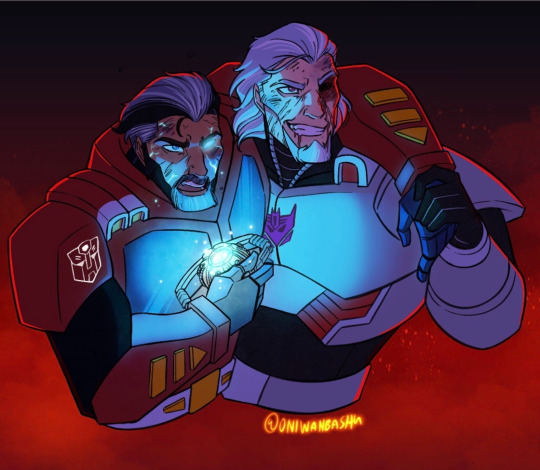
I will admit to this continuity being very much heavy on the relationship between Old Bastards Optimus Prime and Megatron, which is given considerable weight as they were best friends who had known each other since childhood and were deeply intrinsic to each other’s growths as individuals, which makes it all the worse when guilt and betrayal enter the party. Despite being captains in two corners of this battle, there’s a part of them that just cannot let go of their pasts together and they need to reconcile with how this will affect their agenda (Megatron) and how they lead their team (Optimus) who don’t necessarily share their history.
Other characters with significant development include:
Starscream, a Cold Construct in a toxic working relationship with Megatron with whom he is hiding a dark secret, who struggles to balance the underhanded viciousness he believes he needs to gain power and his innate desire from his Senate days to make the world a better place.
Windblade, a Camien native who fights her government’s apathy concerning the situation on Earth which they see as unsalvageable compared to their more Utopian society.
Prowl, a Cold Construct raised from childhood to be a cop in a police state, who finds out that he was brainwashed several times to ensure his obedience and efficacy as a government asset and is now working to reclaim some semblance of the humanity he was never allowed to feel and figure out how much of him is who he really is and how much is programming.
Hound, a sheltered Beastman who joined the fight to ensure that Beastmen the world over would have the same rights he did in his homeland of Shetland Isle, but is forcefully stripped of his humanity and faced with his animal side during the war and has to relearn what personhood means amid his trauma.
Q) Is there a bigger point to this, like a theme or some catharsis? Or is it just fluffy fun?
God with the amount of time I spent sleepless trying to figure out how the logistics of this or the semantics of that were supposed to work in universe, I cannot for the life of me say it’s fluffy fun, but I can’t exactly say it hasn’t been pretty engaging either!
There’s elements of war being messy for everyone involved where there doesn’t seem to be a clear line between friend and foe at times, but I think for most part it prescribes to Jean-Jacques Rousseau’s belief that people are inherently good, but are corrupted by the evils of society. Despite its dark themes (Including but not limited to child abuse, torture, illegal experimenation and brainwashing), love and friendships do prevail, kindness does beget kindness, found families are made, even the smallest actions matter, and things do get better because there are people on both sides who genuinely want to, and strive to make it better.
With Cold Constructs and Beastmen, it also delves heavily into what it means to be human; to have agency and personhood.
There’s also a strong undercurrent of taking responsibility for one’s actions, even if they were made with the best of intentions (Avoidance of this is what eats up Starscream and Megatron from the inside, and what Starscream eventually embraces).
Q) How long have you been working on it?
There’s two answers to this!
I’ve had a Humanformers-related universe going all the way back to 2007 around the time the first Bayformers came out---basically I had a choice between learning to draw cars or draw people (I was an anthro artist back then) and I immediately chose people.
The 2007 draft however had no worldbuilding or connective storylines and was mostly a fun little venture into character design and practice which were actually instrumental to me experimenting and learning how to draw humans properly.
I left the fandom for about a decade and when I came back to it in late 2020 around September via the War for Cybertron series on Netflix, I immediately got hooked on the 2005 IDW comics I missed out on and wanted to get around to updating my old designs as well find a way to translate several of the concepts I wanted to explore in a human sense, so the 2020 update became its own full-fledged original continuity with detailed worldbuilding and history.
You can see the artistic evolution of several characters from their original incarnation below!
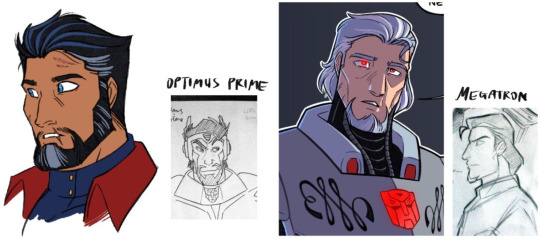


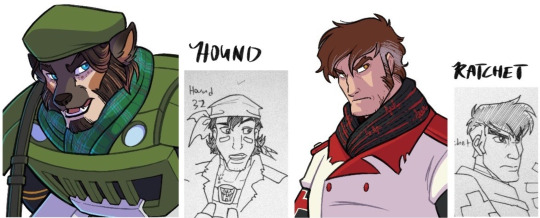
Q) It’s incredible to see your artistic improvement too! Give us a behind-the-scenes look! Show us a secret ;))

Say hello to my workspace! I’ve been working exclusively on the Ipad Pro since late 2016, which is fantastic because I can basically whip up concepts and sketches on the go anywhere. Nowhere is too out of bounds to work on TTB!

Also, do enjoy this sneak peek at true!form Rung, whose synthezoid human body took years to perfect.
Q) YESSSSS alright I must admit this is one of my favorite Rungs, and certainly my fave within TTB. Amazing. Phew, anyway. Where did you draw inspiration from? What canons, what other fiction, what parts of real life?

TTB was initially conceived as a faithful retelling of the IDW 2005 narrative before it was transformed into its own continuity and as such, it borrows heavily from concepts and mirrored plot lines introduced in that run! I chose to have the series inspired off it specifically for the amount of history and worldbuilding it introduced to the franchise.
Anime like Gunslinger Girl and Beastars inspired the depictions of Cold Constructs, especially the more harrowing aspects of their upbringing as government assets instead of children, and Beastmen (Beastformers) in TTB.
I haven’t depicted the world itself in my art all too much, but the architecture from Tiger and Bunny, which has sort of a futuristic Art Deco feel to it, is what you’d usually see in major cities. There is an in-universe reason for that---with a Point Of Divergence set in 1920 followed by 25 years (an entire generation) of progress basically being kicked to the curb due to the Quintesson wars, mankind was basically in a time-locked bubble until the end of the wars, and by then their heroes were 1920s-style rebellion leaders, which lead to 1920s fashion (especially among the Manual Working Class---Megatron, Jazz and Optimus all rock 1920s fashion at some point of their lives) and architecture being celebrated and retained as sort of a reminder of how things were before The Invasion. This anime’s background design is also where I adopted the tiered system TTB’s major metropolises are often built on (with each tier being designated to a different working class) from.
The main artistic style itself is a love letter to 90s cartoons, in particular Gargoyles’ deep and drama-driven character narratives and designs as well as The Centurions’ take on body armor logistics.

I also take inspiration, especially armor-wise, from the characters’ given heritage and background. As an example, Hotrod who is depicted as Irish has the flames on his armor done up with Celtic knots. Welsh aristocrat Mirage’s armor bears olden knight-style filigree and has his Autobot logo designed as a coat of arms. Indonesian Soundwave’s armor and Decepticon logo takes cues from Batik and Wayang Kulit while their mask is based off the Barong.
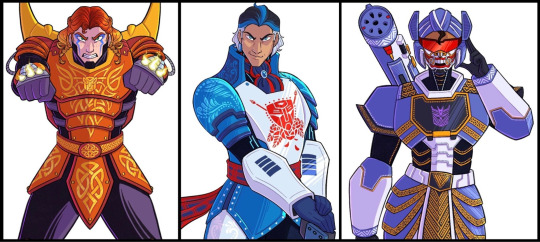
Q) They are absolutely gorgeous! Show off something you're really proud of, a particular favorite part of your cont.
The worldbuilding in general! Most Humanformers I’ve seen tend to treat it like a fun exercise which it is and is definitely valid, but I found myself wanting a full-fledged world to lose myself in and I sought to try and make that world myself by drafting a detailed history and timeline of events which would affect ongoing narratives, having indepth worldbuilding to include almost all societal aspects of the universe and expanding on the concept of Beastmen and Cold Constructs existing in a human setting.
I’m not so secretly proud of the research and diversity included to make the cast look like the multicultural, globally-based team that they were meant to be instead of being locked to a single region! My original draft from 2007 was, to put it simply, quite culturally monolithic and I wanted to improve on that aspect with TTB.
I’m also proud that I’ve kept to it this far! I’m a notoriously flaky person jumping from one idea/fandom to another and to have kept at this continuity for the better part of ten months is honestly a personal feat.
Art-wise, this scene depicting a young Megatron working alongside Terminus and Impactor (cameo by @weapon-up-wallflower‘s OC Missit!) is definitely one of my favorites since it helps build up the world they live in and plays to familial bonds and comfort found in one another despite their less than ideal circumstances.
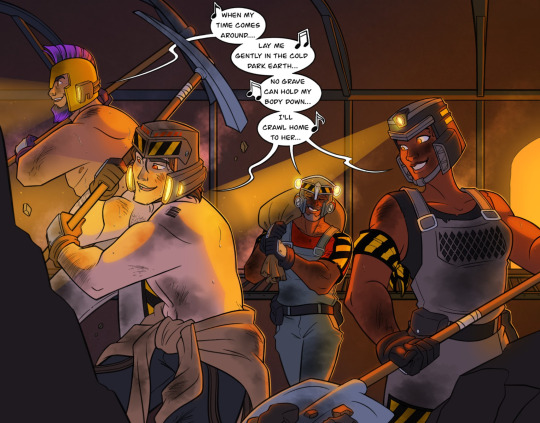
Q) Everything has come together so beautifully, you absolutely should be proud. What other fan canons do you love and why? Would you like to see them interviewed?
I am dying to hear more from @iscaredspider’s Sparkpulse continuity! Her designs are MIND-BLOWINGLY GORGEOUS and I want to hear more about what inspired her to work on it!
Also YOU. Yes YOU BLURRITO. LET ME HEAR MORE ABOUT SNAP.
Q) [wails and squirms away in the mortifying ordeal of being known but in a very flattered way] I WILL SOMEDAY I PROMISE aflghsdjg thank you QwQ
Well that was fantastic, Oni, thank you muchly! A magnificent continuity with so much to look forward to! Coming up next is another personal fave of mine, the first inspiration for SNAP, so stick around...
#long post#gore#ties that bind#spotlight#transformers#HUMANFORMERS#transformers au#tf original continuity#transformers fan continuity#transformers redesign#maccadam#i said id post this on sunday but i realize thats a holiday for lots of folks on this site :/
354 notes
·
View notes
Text
HOMESPORK ACT 5 ACT 1: Mobius Double Plusungood, Part 3
TW: """funny""" sexual and physical assault of a child by another child, extreme bullying, extreme ableism, a very brief discussion of shipping characters outside their canon sexuality.
CHEL: We get some implications of the part of troll culture we ended on last time when a slightly baffled-looking Nepeta, watching through the viewport, updates her SHIPPING WALL. Instead of hearts, some of the hypothetical pairings she’s painted are marked with diamonds. What this means will be explained shortly.
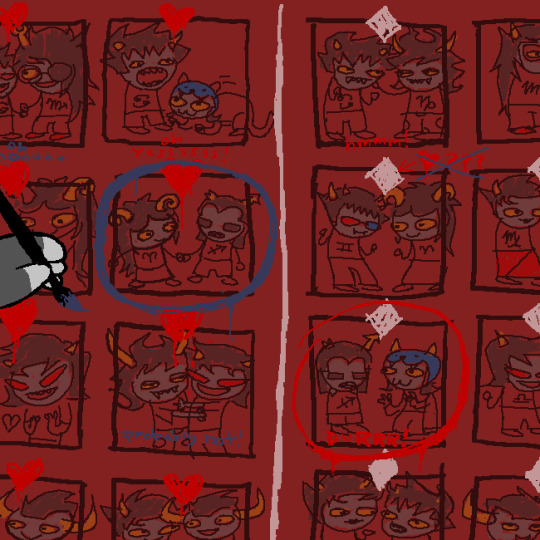
I can’t help but feel it’s slightly creepy to hypothetically matchmake your own friends, but I’m pretty sure the other trolls know at least that the shipping wall exists if not exactly which ships they’re in, and they do live in a society in which it’s stated later that mating is mandatory, so it would indeed be helpful to have at least emergency-doable matchmaking done well in advance and they might appreciate the help.
I’d like to take a moment to note a ship at the bottom row, left of centre; GA/Tavros. Hussie, on his Formspring, later said that GA was “obviously” a lesbian, or anyway was only interested in women, which doesn’t have a specific term for it in troll culture. It’s actually hard to tell going by what’s shown in canon, because she only displays specific interest in girls except for in a complicated case we’ll discuss later, but trolls are supposed to be bi-normative, plus it’s not like the male selection here is particularly inspiring, so, yeah, the evidence we actually see isn't conclusively "obvious". The fandom, knowing this, systematically harass anyone who even muses vaguely about the possibility of shipping her with a boy, even if they don't know about that Word of God. This is why I’m wondering whether the trolls knew about the shipping wall, because if they did, we can presume GA didn’t care. For the record, I’m sex-repulsed ace and have in fact written about.my own imaginary persona fucking (admittedly fucking an opposite sex clone of herself, it was a complicated injoke) and my reaction to someone else writing it would depend on context and reason, so I can imagine her reacting similarly, but not everyone would. A similar thing with a canonically gay male character explicitly on-screen not caring about hypothetical shipping of himself with girls comes up much later; he’s not a troll, but his upbringing was troll-influenced (long story).
BRIGHT: Harassing people over the ships they make content for always baffles me. It’s not like fanart/fanfic for a ship which contradicts canon has any effect on the canon, and playing around with character dynamics (often in a pornographic manner) is a major part of fanfic.
CHEL: On top of all this, gender and sexuality are really shaky concepts to even try to apply to a species which reproduces hermaphroditically. On this side of the fourth wall it’s obviously because Hussie is a not-very-reflective cisgender heterosexual man, and didn’t think about it any further than “girls wear skirts, right?” Plenty of people fanwank up possibilities for how it could happen on the other side. I think we may have to make a “What The Fuck Is Alternian Biology And Sociology” post or two separate from the sporking at the very end.
Discourse discussion over! Next page, we see some of the relevant terminology used in troll culture, though we still don’t get any explanation of what any of the words actually mean, which is a tad annoying for new readers. The context is a discussion between Karkat and Vriska about getting her into the game.
BRIGHT: Specifically, Karkat wants Vriska to get Tavros into the game, leading to this exchange…
CG: WHY DO YOU EVEN HATE HIM, IT'S FUCKING RIDICULOUS. CG: IF ANYTHING YOU SHOULD PITY HIM. CG: ESPECIALLY SINCE YOU WERE THE ONE WHO PARALYZED HIM. AG: I know. I don't really understand it. AG: It's just a really special kind of h8! It never goes away and it doesn't make a lot of sense. CG: THIS IS KIND OF A WEIRD TIME TO BE CONFIDING IN ME ABOUT YOUR FEELINGS OF BLACK ROMANCE BUT OK. AG: Oh god, what? CG: I MEAN IF YOU'RE REALLY IMPLYING TAVROS IS YOUR KISMESIS I THINK YOU'RE BRAYING UP THE WRONG FROND NUB. CG: BOTH PARTIES HAVE TO HATE EACH OTHER EQUALLY, I MEAN LIKE TRUE HATE. CG: MAYBE YOUR FEELINGS COME SOMEWHAT CLOSE TO FITTING THE BILL BUT I DON'T THINK HE CAN HATE ANYONE, IT'S WEIRD, HE'S KIND OF BROKEN IN THE HEAD.
Finally, our long-awaited introduction to troll romance!
And the introduction is an effective one. We now know that there’s something called ‘black romance’, that it concerns hate, and that one’s black-romantic partner is a ‘kismesis’. The conversation also flows naturally and fits the characters having it, rather than being an awkward as-you-know infodump, although brace yourselves, there’s one of those coming up. Thirteen is about right for kids starting to have romantic feelings and being confused about it, not wanting to talk about it is pretty normal, and Karkat lecturing people at a good opportunity is absolutely in character.
Karkat goes on to lecture Vriska about the emotions involved in different sorts of romantic relationships, and wow, it really says a lot about troll culture…
CG: OK, MOST PEOPLE WHO HAVEN'T HAD THEIR LOBE STEM CAUTERIZED ARE CAPABLE OF FEELING THE TWO PRIMARY EMOTIONS, HATE AND PITY. CG: PITY IS OF COURSE JUST THE TONED DOWN VERSION OF THE CENTRAL EMOTION, HATE. CG: AND ALL THE NUANCES OF PITY MANIFEST AS VARIOUS OTHER KINDS OF FEELINGS LIKE WHATEVER CHEMICAL REACTIONS TRIGGER MATING FONDNESS OR THE MYSTERIOUS FORCES THAT ARE BEHIND MOIRALLEGIANCE.
CHEL: It’s never really clear if this is just Karkat’s idea of it or if this is how trolls actually work biologically. Trolls do use the word “love” later on, so I always interpreted it as “pity” being a euphemistic term because “love” in such a warlike and oppressive culture could be exploited as a weakness. Fandom has played it with their love actually being based on a weird form of sympathy/seeing the other as needing protection, which is also plausible.
FAILURE ARTIST: I have played with the pity thing before but in retrospect Karkat is the only one who seems to see it that way. Maybe this is all his fake deep teenager view of romance.
BRIGHT: Vriska makes a performance of how bored she is, but Karkat’s on a roll.
CG: A WELL BALANCED PERSON IS IS GOING TO HAVE A GOOD DISTRIBUTION BETWEEN HATE AND THE VARIOUS PITY HUMORS. CG: HAVING A GOOD BALANCE KEEPS ALL THE EMOTIONS SHARPER, SEE I THINK THAT'S YOUR PROBLEM. AG: Oh???????? AG: I hope you know I already wore out some good note-taking pens today. All the pens. AG: All of them. CG: SEE, MY HATE IS LIKE A FINELY TUNED INSTRUMENT BECAUSE I'M AWARE OF THESE PRINCIPLES. CG: I COULD HATE A HOLE IN PARADOX SPACE ITSELF, STRAIGHT THROUGH TO A NEW REALITY FRESH FOR THE HATING. AG: Hahahahahahahaha, you don't even know how much I'm laughing at this. CG: BUT SEE, YOU'RE TOO HEAVY ON THE HATE SIDE, OR AT LEAST YOU PRETEND TO BE WHICH IS MAYBE WORSE. AG: You aren't reading anything I say are you? You just want to talk and talk and talk. CG: AND YOU THINK YOU'RE HATING UP EVERYONE HARD WHEN YOU'RE REALLY JUST BURNING OUT THAT ENTIRE EMOTIONAL HEMISPHERE. CG: IT'S LIKE LUKEWARM HATE. PRETENDER'S HATE, WITH NO COUNTERPOINT AT ALL. CG: AS SUCH THERE'S NO REAL SUBSTANCE TO YOUR HATE, IT'S LIKE A CARDBOARD MOVIE PROP. CG: WHICH IS WHY YOUR BRAIN IS BROKEN, KIND OF LIKE TAVROS'S BUT ON THE OPPOSITE HEMISPHERE I GUESS. CG: OR MAYBE YOUR BROKEN BRAIN LED TO THE IMBALANCE IN THE FIRST PLACE, I DON'T KNOW. CG: WHATEVER THE CASE IS, YOU'RE KIND OF EMOTIONALLY SCREWED, SORRY TO SAY. CG: YOUR HATE'S TOO DULL FOR A PROPER KISMESIS, IN MY OPINION. CG: AND I DON'T SEE ANYONE CHOMPING AT THE BIT TO BE YOUR MOIRAIL HONESTLY, UNLESS THERE'S SOMEONE OUT THERE WHO WOULD ACTUALLY BOTHER PITYING YOU. CG: AND LANDING A MATESPRIT? HAHAHAHA! CG: SERIOUSLY, LIKE THAT WOULD EVEN INTEREST YOU. CG: BASICALLY ANY FEATURE OF YOUR EMOTIONAL PROFILE THAT USUALLY MAKES SOMEONE VIABLE IN THE REDROM DEPARTMENT MUST BE TOTALLY FRIED. CG: YOUR BLACKROM POTENTIAL'S PROBABLY TOAST TOO.
Whew.
So now we have ‘kismesis’, ‘moirail’, and ‘matesprit’ as terms for romantic partners, as well as the concepts of black romance, red romance, and ‘moirallegiance’ as the relationship one has with a moirail. Troll romance is not going to get any less confusing for a while.
If Karkat’s grasp of psychology strikes you as amateurish, there’s a reason for that: He gets all his knowledge from romance movies.
AG: Hey asshole, stop watching movies for girls.
I think that’s another strike against the ‘girls are the dangerous ones on Alternia’ argument. Romance movies, per this exchange, are both female-coded and seen as inferior -- Karkat defends his viewing choices by saying they’re INTRIGUING SOCIOLOGICALLY, but Vriska isn’t buying it.
CLOCKWORK PROBLEMATYKKS: 42 WHITE SBURB POSTMODERNISM: 33
CHEL: I’m not sure an interest in the workings of romance should be a socially gendered thing in a society where, as it turns out, you have to have an acceptable romantic partner by a certain time or die. You’d think most kids would be trying as hard as they could to learn and put into practice everything they could about it, and you’d also think there’d be better information for them than romcoms.
BRIGHT: Has the mate-or-die part come up yet? I’m not sure when Hussie thought of it.
CHEL: I don’t know if he’d thought of it yet, but it does come up very soon.
BRIGHT: Karkat then moves on to the original reason he contacted Vriska -- he needs her and her mind powers in the game, because he’s just run into a double agent called Jack.
Over on the next panel, Karkat is still talking to Vriska, but he’s glancing back over his shoulder at Jack Noir. His hand is covered in blood, which keeps cycling through a range of colours. The blood, it transpires, is because Jack stabbed him. Karkat is amazingly calm about this.
CG: HE'S COOL, IT'S FINE I DON'T REALLY MIND THE STABBING, IT WAS ALL A MISUNDERSTANDING. CG: WELL OK I'M PRETTY SURE HE MEANT TO STAB ME. CG: BUT I KIND OF THINK THAT'S LIKE CG: THE WAY HE GREETS PEOPLE? AG: This game is so stupid. CG: IN ANY CASE I THINK HE'S PROBABLY ALL STABBED OUT.
This would be ridiculously chill even from someone who isn’t extremely cagey about his blood colour -- and it’s not that Karkat suddenly doesn’t care any more, because as soon as Vriska says she’ll ask Terezi or Jack what colour he’s bleeding, he tells her that he’s out of Terezi’s range, Jack is sworn to secrecy, and Sollux (who’s incommunicado) is the only one who knows how to make Trollian’s viewport feature work. (Given we saw how easy it is to use earlier, I’m surprised Vriska doesn’t try to figure it out herself.)
Over on the next panel, the viewer is now Jack, a few minutes prior to this conversation. Contrary to Karkat’s protestations, Jack stabs him because He's got a pretty sharp tongue and can't seem to keep it sheathed. He is curious when Karkat cares less about the wound and more about Jack seeing his blood colour, which is apparently some freakish mutation. Jack looks at his knife…
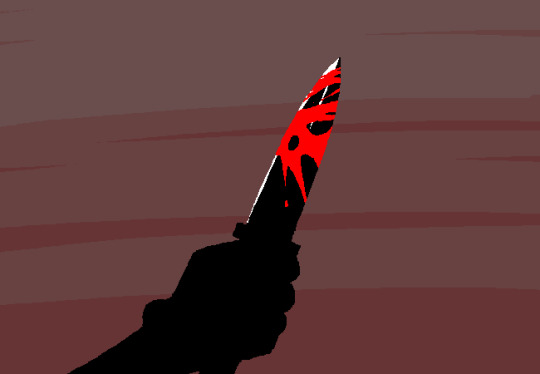
CHEL: While it’s not a realistic depiction of the colour, recall that this is the shade of red used in-comic to depict human blood. This reveal probably isn’t a surprise to anyone by now, if you’ve encountered fanart, and honestly it wasn’t a huge mindblowing revelation on my first read before I knew, but I do think it’s a clever little “aha, THAT’S why!” moment. Skilfully done.
It seems he's the only one of his kind with this mutant candy-red blood. An outcast. He thinks he was put on this planet covered in an ocean of his own blood to be taunted. Punished for something. Saddest story you ever heard. Got to do something to shut him up.
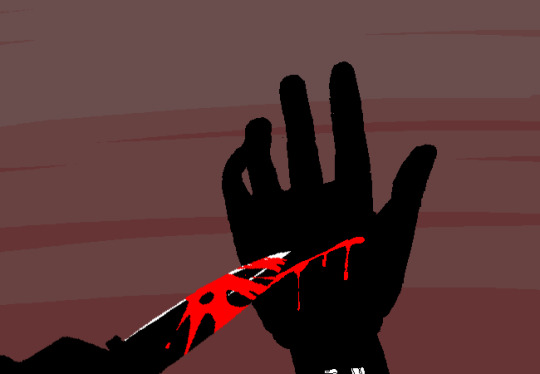
BRIGHT: Awww. That’s kind of sweet.
This little interchange gave rise to the ‘Stabdads’ fandom phenomenon, where Spades Slick is envisaged as Karkat’s father-figure. In Homestuck canon, it’s dubious how much affection Slick has for Karkat. He seems more irritated by him than anything else, but that’s about on par for how he treats the rest of the Midnight Crew. On the other hand, it clearly makes a massive impact on Karkat. We’ve seen how important blood colour is on Alternia and how insecure he is about his own; his sudden rush of fellow-feeling towards Jack is understandable, even if it does make him way too forgiving about having been stabbed.
CHEL: Karkat and Jack shake hands, and proceed to be in cahoots. Cahoooooooots. Doodling on the defaced parking ticket from earlier, they draft OPERATION REGISURP.
Your whole team executes the plan along the course of its journey, employing espionage, mind control tactics, political sabotage, vicious interrogations and cold blooded assassinations. Everyone does their part and you begin to learn the true meaning of teamwork, as well as this troll disease called friendship.
Yeah, it actually happening is skipped over with one paragraph, but that’s probably a good thing with all the complexity already going on, and we do hear more details about it. First, we’re reminded of the existence and functions of the Queens’ Rings, the magic rings the queens of Derse and Prospit have which give them traits and powers from whatever the players put in their sprites. The trolls have put their lusii in their sprites, except for Aradia, whose lusus died long ago, so she got in the sprite herself. The Queen could put up with getting bits and pieces from eleven hideous monsters (well, ten hideous monsters and one adowable little fairybull thing oh my gosh it’s cuuuute) tacked onto her, but what she absolutely won’t stand for is the other thing Aradia put in her sprite…
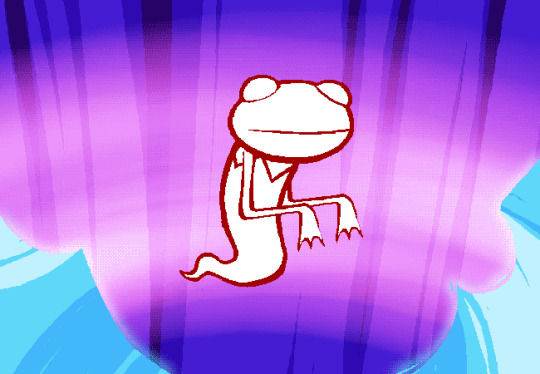
She could not stand bearing the visage of the most loathsome creature known to existence. So vile is its appearance, so contemptible its purpose, all depictions of the creature let alone members of its population are permanently banned from any jurisdiction in the reach of her agents. Those of its kind go by many names, and so does the reviled patron god they herald - THE GREAT DETESTATION, KING PONDSQUATTER, SPEAKER OF THE VAST JOKE, or most commonly, BILIOUS SLICK.
Recall that AR thought of the hieroglyphs in the Frog Temple as “illegal pictography”. We’ll find out later why the Black Queen has such a revulsion for frogs, it’s important. But the important part right now is that she took the ring off. At the time of planning it’s in the ROYAL VAULT.
We briefly see a moment in the future of the Black Queen wrapped in rags, just like the human sessions’ White Queen, wandering the desert as the BANISHED QUASIROYAL, and the caption notes the plan was a success.
However, Doc Scratch appears in the desert in front of her, and it’s noted she was given a new purpose. This, it seems, is the origin of Snowman.
FAILURE ARTIST: I would like if there was some canon Homestuck material expanding on this REGISURP plot.
BRIGHT: Same! It sounds really interesting. One example of Homestuck’s idiosyncratic pacing, I suppose -- we spend pages and pages on trivial alchimeter nonsense, but skip over something more meaty.
CHEL: The Red Team work on that, while the Blue Team battle their own session… or so they think. Yeah, I’m sure you’ve all already figured it out, but the trolls hadn’t just yet. They note that their prototypes are affecting the opposite team’s underlings, and the readers are shown Alternia’s two Frog Temples, one near Aradia’s home and the other near Kanaya’s, each with six pillars outside (one seems to have five, but the sixth is hidden behind the building). Superimposed on each other, the pillars make a full ring of twelve.
The truth was it had always been the same session all along. That your teams were not competing, but cooperating toward a common goal. In the more drawn out form of this adventure's narrative, figuring this out would have been a huge deal. We would have been completely blown away by this stunning revelation. Wow. Same session all along. Really? Huh.
This is what Aradia’s been so mysterious about. She knew. We’re provided with a handy diagram, in case we haven’t been able to keep up.

After watching the phrases MOBIUS DOUBLE and REACH AROUND toggle for a few minutes while in a sort of stupor, you finally snap out of it.
(I just noticed, the Blue Team are the Derse dreamers and the Red Team are the Prospit dreamers. Neat!)
The reader’s attention is drawn instead to the Aquarius and Pisces symbols in the top left, belonging to characters we haven’t met yet, and the narration promises we’ll learn about them soon. Drawing attention again to GA’s Virgo symbol, the narration muses about her.
It will probably be quite some time before you get to be her. It could very well be pages and pages and pages.
Naturally, we jump right back to her.
GA’s intro is long, so we’ll take it piece by piece.
Your name is KANAYA MARYAM.
The Sanskrit name for Virgo is “Kanya”, and it’s also the name of a town in Japan. “Maryam” is the Arabic version of “Mary”, as in Jesus’ mother. It may also be a reference to Marya Zaleska, the title character of the movie “Dracula’s Daughter”.
You are one of the few of your kind who can withstand the BLISTERING ALTERNIAN SUN, and perhaps the only who enjoys the feel of its rays. As such, you are one of the few of your kind who has taken a shining to LANDSCAPING. You have cultivated a lush oasis around your hive, and in particular, you have honed your craft through the art of TOPIARY, sculpting your trees to match the PUFFY ORACLES from your dreams. You have embraced the tool of this trade, which conveniently is the weapon of choice for those who would hunt the HEINOUS BROODS OF THE UNDEAD which crawl from the sand at sunrise to feast on the light and the living.
Couple things established here; trolls are not only nocturnal but actively harmed by their planet’s sun, and undead beings other than ghosts exist. Said traditional weapon for hunting them is a chainsaw, which we can see lying against her bookshelf, a reference to the Evil Dead movies.
It would be convenient if you actually hunted them, but it is of course far too dangerous, every bit as suicidal as attempting to poach the terrible MUSCLEBEASTS who roam at night. So you indulge in your bright fascination with the grim through literature. Just before the sun goes down and you join your flora in rest, you immerse yourself in tales of RAINBOW DRINKERS and SHADOW DROPPERS and FORBIDDEN PASSION.
Rainbow drinkers are, as discussed later on, troll vampires. I don’t think shadow droppers are ever expanded on, but they might be zombies or werebeasts. Troll goths, apparently, are the reverse of human goths, dressing in bright colours and staying up in the daytime, which makes sense for a species who can only safely go out at night.
You are one of the few of your kind with JADE GREEN BLOOD. As such you are one of the few who could be selected and raised by a VIRGIN MOTHER GRUB, an event so rare as to elude documented precedent. She would defend you from desert threats, and though her life would be short, in time you would assure her of progeny.
Recall that the Mother Grub is required for troll reproduction.
You are a SEAMSTRESS or a RAGRIPPER or a TREETRIMMER or a LUMBERJACK, whichever you care to be, and your unique hive is equipped with a great supply of advanced technology to accommodate your interests. The technology and indeed the hive itself were all recovered from the ruins nearby when you were very young. The seed of your hive was deployed on the volcanic rocks beneath the sand with the assistance of your lusus and her remarkable burrowing skills, and you have lived there happily together since. You know the ruins and the hive and everything here that is not sand and rock originated from the world of your dreams. You also know that one day you will visit this world while you are awake. That day is today.
Like Jade, Kanaya has been awake on Prospit for years, and the technology in question is Skaian in origin, so that’s how she knows what’s going on with the game.
Kanaya is prompted to equip her chainsaw, which promptly turns into a lipstick in a Problem Sleuth reference. Like Jade, she has a Wardrobifier, set to randomise, which suddenly turns her black shirt and red skirt into a red leaf-print dress. She takes out the lipstick.
You can choose between your trademark jade or black. Even though a troll's lips are naturally black. But they can always be blacker, and a lady with a true sense of style knows this.
She goes with green, her dress turns into a blue kimono, and she’s messaged by someone with a fuschia Pisces symbol. This person, named cuttlefishCuller, turns out to be rather excitable, greeting her in all caps and following it up with Glub glub glub glub glub!
BRIGHT: This conversation is pretty sweet, with some friendly joking about CC’s quirk (they stick hyphens in front of their capital Es) and mention of their Collapsing And Expanding Bladder Based Aquatic Vascular System. There’s another mention of moirails, with CC saying they’ll have to join the game late to keep an eye on theirs.
It also turns out both CC and Kanaya are having some premonitions of what’s to come! Kanaya is seeing visions in the clouds of Skaia, the same way Jade does, but CC hears whispers from a mysterious ‘she’ who needs her voice keeping down. It’s implied to be CC’s lusus, as both Kanaya and CC are aware their lusii are going to die soon.
Kanaya hopes to be with her lusus as she dies, but looks out of the window to find the Virgin Mother Grub has already passed away, apparently of natural causes.
CHEL: The Mother Grub was seen briefly before; it’s a moth-like creature with a huge fat body the size of a bus, with wings too small to ever lift it, horns the same shape as Kanaya’s, and a skull-like head with big lips. The skull on Terezi’s Doomsday Scale was, we can tell now, a Mother Grub, except quite a lot bigger - presumably a breeding Grub.
BRIGHT: Kanaya changes back into her original outfit, and goes down to live up to her end of the bargain… which entails slicing a hole in her lusus with her chainsaw and pulling out a round object covered in spikes the colour of trolls’ horns, called a Matriorb. Kanaya stores it in her sylladex; she’s using a CHASTITY MODUS, which locks each card away, and the key will serendipitously be discovered when it’s time for the card to be unlocked. These modii are getting more and more esoteric.
Kanaya proceeds to have a conversation with her own moirail, Vriska, which we already read earlier.
You then proceed to have the rest of this conversation we already read, bugging and fussing and meddling through the special and magical union one can only describe as being in moirallegiance with another. At least, you guess that's how you would describe it. Maybe. Troll romance sure is confusing!
Yes, yes it is. (Spoiler: It’s not that confusing once it’s explained.)
Kanaya doesn’t have long to dwell on the conversation, as she’s contacted by caligulasAquarium, someone with a violet Aquarius symbol who she doesn’t seem to think highly of. It rapidly becomes apparent why.
CA: kan make her talk to me do somethin GA: Who CA: your no good connivvin fuckin backstabbin girl crush thats wwho
CHEL: Trolls are supposed to come bi/pan as standard, so why does he need to specify “girl crush”? I wonder if Hussie hadn’t decided that yet when he wrote this part, but I’m not sure.
WHITE SBURB POSTMODERNISM: 34
CA’s gender hasn’t been revealed, but let’s not kid ourselves, we know from how he’s talking that he’s a dude. Nice Girls certainly exist but they don’t tend to get portrayed as so whiny in fiction, plus CC comes off as very girly, and that leaves us with six boy and six girl trolls. Balance and opposites and counterparts are a running theme throughout Homestuck. Not that there can’t be nonbinary characters, as some show up in Hiveswap; just that there would most likely have to be an even number of them, split evenly between the groups of players. Fine by me as a nonbinary person with a thing for balance and even numbers of my own.
Also, note that we’ve seen this guy, or at least his hand and foot, before. This is the litter-hater in the bowling shoes.
GA: Overstating Our Relationship Wont Make Me Feel Very Cooperative GA: Its Paler Red Than That Ok CA: pshhhhhh that is a fuckin laugh and you knoww it evveryone does CA: so help me out tell her to talk to me i think she blocked me you got to GA: Why Do I Got To GA: I Dont Got To And Every Time You Take My Help For Granted I Feel Like I Got To A Little Less CA: wwhatEVVER you are so the vvillage twwo wwheel devvice wwhen it comes to auspisticing CA: you cant let a grudge go by you wwont stick your busy stem betwwixt so get wwith the program fussyfangs
BRIGHT: Oh hey, another troll romance term! ‘Auspisticing’ is the last of the lot, don’t worry.
CA: wwho givves a shit wwhy she blocked me or about my fuckin manners come on youvve got a wway wwith her CA: i figure if youre going to auspisticize any twwo brinesuckers wwho sneer at each other a funny wway you might as wwell make it official and be ours right GA: Your Black Solicitation Just Seems Really Indecent
Funny words aside, Hussie does a good job at laying down context for what auspisticism is here; we now know that it involves mediating between two parties who dislike each other and that it’s a form of black romance. Meshing worldbuilding naturally into the dialogue is something Homestuck does really well at times.
Anyway, CA is trying to get in contact with Vriska because he asked her to make something for him and now she’s blowing him off.
GA: What Is It CA: kan stupid wwhat do you think its a fuckin gizmo to bloww up the wworld or somethin CA: ok wwell not that obvviously CA: but somethin thatll kill all land dwwellers wwhat else wwould i be after GA: Can You Just For A Moment Entertain The Thoughts Of One Untouched By Megalomaniacal Derangement And Tell Me Why Id Want To Assist You With That CA: wwell CA: im not goin to vvery wwell kill you am i that wwould be fuckin unconscionable CA: wwhat kind of friend wwould i be
While CA is obviously a douche, there’s something funny about how over-the-top he is about it and how utterly oblivious he is to the idea that Kanaya might have a problem with a device that would kill all landdwellers, although the humour is inversely proportionate to how likely he is to pull it off.
CHEL: Maybe I’m strange, but I think he’s adorable. I get the impression of a small kid trying to puff himself up to adult size.
BRIGHT: There’s also more romance talk, and this next bit is one I find interesting:
CA: you could either play along as our auspistice and do a little mediating like you wwere fuckin hatched to CA: or wwatch she and me devvolvve into fuckin full fledged kismesisses the kind like you dont get once in ten thousand swweeps CA: you knoww thats wwhat it wwould be there wwould be rainboww rivvers runnin through star systems and all nebulizin like liquid firewworks CA: it wwill be beautiful and heartbreaking all at once CA: you should read up on your history instead of poring through that godawwfull sunny rubbish
I’m going to take a step back from Homestuck itself for a moment and talk about kismessitude as it’s portrayed in fandom. People tend to envision it in a variety of ways -- some see it as a BDSM relationship, some as a way of pushing a rival to be better, some as just straight-up hate-sex -- but most depictions show it as something that only affects the two people involved.
Here, though? CA’s talking about kismessitude as something that’s potentially really damn dangerous, to other people besides those involved, and cites history as a backup -- implying it can really be that dangerous, and it’s not just a teenager’s flight of fancy. (Although, that said, CA is clearly using this to try and get Kanaya in a relationship with him, so how sincere he is is questionable.)
CHEL: Later on we do see a little bit of one of the historical cases he might have been citing. We’ll discuss it more then. Also, I do like him saying “sunny” instead of “gloomy”. Makes sense!
Kanaya tells CA none of this matters, and he sneers about the “purity of the bloodline”. That’s an… uncomfortable turn of phrase, especially since he’s speaking to someone not covered by the “purity” standard, but since it applies to aliens and it’s in a society where that’s hammered into its inhabitants it’s not a Problematykks issue. Kanaya tells him it still won’t matter because their race will be wiped out entirely, and his reaction is remarkably understated:
CA: huh CA: wwell ok HURRY UP AND DO NOTHING: 11
CA says he knows Kanaya doesn’t lie except to herself, surprisingly perceptive for one so puffed-up otherwise. CA might be smarter than he’s letting on? He asks if her clouds told her that; that was the reader’s assumption too, but she says no, she has a different source. Uh-oh. We know what the last source of information was, and it cost Vriska an arm and an eye-sevenfold. CA’s own clouds “hide nothin but misfortune and monstrosities”, so we can guess she’s Prospit and he’s Derse. He goes back to nagging her to tell Vriska to talk to him, and when she continues to refuse he poutily steps off.
CA: you dont wwant to be our auspistice cause you dont wwant to get locked into that sort of relation wwith her i can respect that
Kanaya denies this, and CA says everyone knows, including Karkat.
GA: Its Unbelievable GA: Her Patience CA: wwhat CA: wwhoa wwait wwho GA: Never Mind CA: ok wwait did she talk to you today CA: wwhat did she say CA: or glub or wwhatevver
They’re talking about CC, if it wasn’t clear. Kanaya, in a callback to John’s comment to Terezi, facetiously tells him that she talked about Longing To Touch You Indiscretely and That Shes Basically In The Scarlet Throes For You. CA, flustered, picks up that she’s teasing him, and she tells him the truth, that CC’s just concerned as a moirail.
CA: if youre not savvvvy about howw you define yourself to people CA: you can just splash into the moirail zone before you knoww wwhich wways upwward
I’m going to comment on this attitude in a bit more detail when we get a clearer explanation of what moirallegiance actually is. CA leaves her with some arc words.
CA: being a kid and growwing up CA: its hard and nobody understands
Kanaya heads back to her room, planning to emphatically not meddle but help her friends, and consults her source; it’s fortunately not a Doc Scratch-related one at all. It is, in fact, Rose’s long-forgotten GameFAQ, saved on a server floating in the Furthest Ring, to which Prospit’s clouds directed her. I have to show you the panel for a moment though…
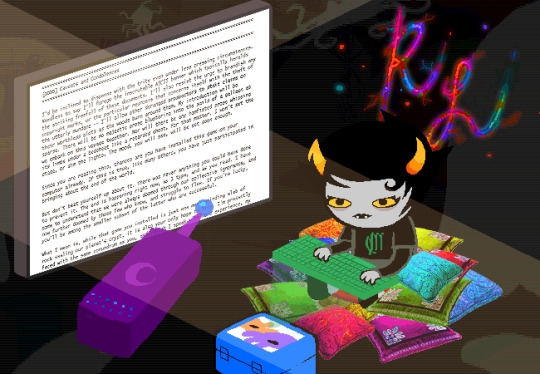
I’m sure there was a way we could see the screen without having it facing away from Kanaya who’s supposed to be reading it.
You can only assume this took place a long time ago. This race is likely ancient, preceding yours by millions of sweeps. Maybe billions! You like to try to imagine the adventures of these players. Were they successful in repopulating their race? Did they manage to protect their matriorb and hatch a new mother grub? Could they hold it together, or were they torn apart by the complex social dynamics, the matespritships and moirallegiences and auspisticisms and kismesissitudes that will surely plague your group along the way? You have little doubt they succeeded with flying colors.
Oh dear, dramatic irony. Kanaya fantasises about a troll version of Rose, thinking she must have been the leader of this supposedly long-ago group.
And yet they appear to have been the only of their kind to have risen to the challenge in a session stacked heavily against them.
Huh. So is this just because Kanaya can’t find more information, or are the four kids in fact the only humans who successfully got into the game? Picking four specifically white-coded kids to be the last of the human race due to supposedly their own competence is… not a good choice. And why the hell couldn’t other people succeed? This strikes me as more of the whole theme of “nobody matters except the people we’re focusing on”. A good lampshading of video game tropes, but in a literary story, that’s the opposite message to everything I’ve ever read, and it’s a creepy one.
CLOCKWORK PROBLEMATYKKS: 43 HURRY UP AND DO NOTHING: 12 WHITE SBURB POSTMODERNISM: 35
BRIGHT: I thiiiiiiiink it’s at least implied later on that there are other sessions going, it’s just that each session is a closed loop of players so we don’t see the others...although if that’s the case, does that mean Earth’s getting hit with meteors from multiple Skaias?
CHEL: That over with for the moment, we cut to Tavros’ house as you take your place as the PAGE OF BREATH in the LAND OF SAND AND ZEPHYR. Vriska, his server player, gets down to the business of building up his house towards the Gate…
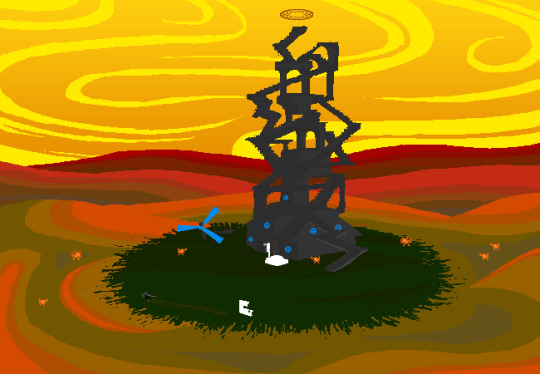
… entirely out of staircases.
AT: i THINK THIS, iS, AT: pROBABLY MEANT TO ANTAGONIZE ME,
Okay, this probably makes me a bad person, but I’m crying with laughter at his expression and that line.
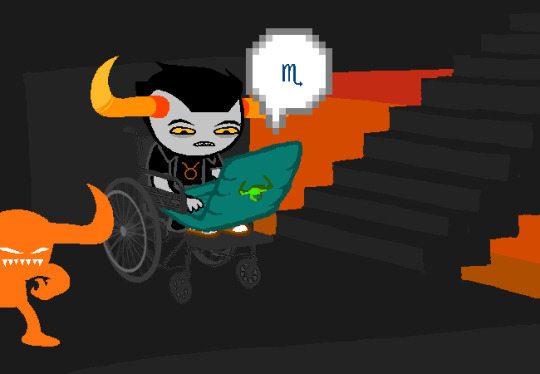
It’s more disability slapstick, but here the point of the joke comes off as being more that Vriska is a jerk and Tavros’ reaction is really understated than any reasonable person being supposed to assume Tavros is wrong for not being able to climb stairs. Emphasis on “comes off as”, unfortunately. I’m still gonna give a Problematykks point, and further experience with Hussie’s attitude to disability has soured the joke somewhat, even in just the next couple of pages.
CLOCKWORK PROBLEMATYKKS: 44
BRIGHT: Vriska tries to get Tavros to crawl up the stairs, first by telling him that he promised not to be boring anymore and then by saying that she’s trying to help him get stronger. She caps off the rant by demanding that he apologise.
AT: oKAY, AT: tHANKS, i GUESS, AT: bUT, AT: sORRY FOR WHAT, AG: For 8eing crippled, you ass! AT: yOU WANT ME TO APOLOGIZE, AT: fOR BEING PARALYZED, AG: Yes. AG: Say you're sorry. AT: i DON'T MEAN TO BE RUDE, oR bORING, AT: bUT THAT'S RIDICULOUS, gIVEN, AT: uH, tHE CIRCUMSTANCES, AG: 8ullshit! AG: It's something called 8asic decency and civility you fudge8looded 8oor. AG: Now get down on your useless wo88ly knees and apologize. AT: nO, i DON'T WANT TO, AG: >::::O
Vriska, what the fuck.
Tavros is really great here. He’s obviously not comfortable fighting with Vriska, and repeatedly tries to redirect her into building him ramps instead of engaging. But, at the same time, he holds his ground and doesn’t let her push him around, and won’t let go of solid hard reality in the face of Vriska trying to emotionally manipulate him.
FAILURE ARTIST: And yet people still call him a wimp.
BRIGHT: Vriska retaliates, because of course she does, by grabbing his wheelchair with her cursor and shaking it about. If Hussie left it at that, everything would be unobjectionable, at least in terms of narrative voice. Instead, well…
Now she's done it. She has awoken the mighty inner fury that is... RUUUUUUUUUUUUUUUUUUUFIIIIIIIIIIIIIIIIOOOOOOOOOOOOOOOOOOOOOOO!
CHEL: It just occurred to me to mention that the name Rufio comes from a character in the movie Hook, the leader of the Lost Boys after Peter Pan left, played by Dante Basco. Tavros’ mental image of him is a reference to that character.
FAILURE ARTIST: Dante Basco did read Homestuck, with hilarious results as we will see.
But unfortunately, Rufio is not real. He's imaginary. A fake. Like a made up friend, the way fairies are. You continue to be sad and alone.
BRIGHT: Eurgh.
Let me be clear: Tavros having no further recourse to deal with Vriska’s abuse beyond his visualised self-esteem is a problem for the character, but it’s not necessarily a narrative problem per se. Escapism is a thing. You could get a decent character arc out of Tavros learning better ways to deal with harassment he can’t escape. It is a narrative problem when the narrator mocks it and makes him out to be pathetic for even trying it.
CHEL: I’d consider this to be just Tavros’ own thought process, but, sadly, this kind of narrative sneering at him carries on throughout Tavros’ presence in the comic and the fandom seems to buy into it. Tavros gets a lot of hate for reasons which mostly boil down to him being a male abuse victim; there’s a feeling that he should “try harder” to fight back, despite him being physically disabled and a member of a caste out of sight beneath her on the social ladder and legally permitted to be killed by her on a whim. Might that count as a point for WHITE SBURB POSTMODERNISM, for Huss and the fandom not taking the social dynamics into account for why Tavros can’t defend himself?
BRIGHT: I don’t know if it’s fair to count against the fandom when we’re reviewing Homestuck proper, but we can definitely count against Hussie!
WHITE SBURB POSTMODERNISM: 36
CHEL: It’s also notable that the common fandom interpretation of Tavros is as Hispanic-coded, at least partly due to his Spanish username, and of Vriska as white-coded. That’s probably not helping.
Since Hussie appears to expect us to agree with Vriska that this is funny, I’m adding another to these as well.
ALL THE LUCK: 2 CLOCKWORK PROBLEMATYKKS: 45 IN HATE WITH MY CREATION: 3
BRIGHT: What’s weird about this whole mess is that Hussie doesn’t — yet — try to say that Tavros should be trying to get stronger; his disability is fully acknowledged. I feel like this kind of mockery is usually accompanied by the attitude that disabled people should just get over their disability, but Hussie’s clear that Tavros can’t. Which means he should do...what, exactly?
CHEL: Not have let Vriska disable him in the first place, presumably. Never mind that, you know, she has mind control powers so he didn’t really have a choice in that either. That is, however, an argument Vriska fans actually make. Apparently some of them actually blame him for not flying when she threw him off the cliff, which… well, unpowered flight is a thing that can happen in the comic but he certainly couldn’t do it then.
BRIGHT: ...Apparently I retain the capacity for surprise at how awful people can be. The fuck?
Back in the comic, Tavros fortunately does have one other means of recourse. Back in her hive, Vriska is suddenly prodded in the back with a flying toilet, courtesy of Kanaya.
GA: Just Presenting A Floating Reminder That Tavros Will Need Plenty Of Inclined Surfaces For His Ascent AG: That's silly. I made so many ramps, you wouldn't even 8elieve it. AG: I specifically decided I wanted to 8uild something ugly and 8oring. It is now the land of ramps and yawns. GA: Hes Reported Otherwise AG: That lousy snitch! May8e I should take his computer away so he can't go crying to fussyfangs anymore. GA: Maybe I Should Upend This Load Gaper Over Your Head AG: No, don't! GA: Im Still Learning The Interface GA: It Could Happen Accidentally At Any Moment AG: I'm only trying to help him. ::::( GA: Think Of Another Way To Help
CHEL: Did I mention Kanaya is my zodiac troll? I can only long to reach her heights of awesome. Of course the ability to levitate toilets would kinda help.
BRIGHT: Vriska heads down to her treasure vault and retrieves a pair of ROCKET SHOES. The captchalogue code for these is ‘PSHOOOES’, which amuses me greatly. Vriska sends the code to Tavros, who combines it with the code for his wheelchair to create a flying wheelchair. Now that is a good use of alchemising!
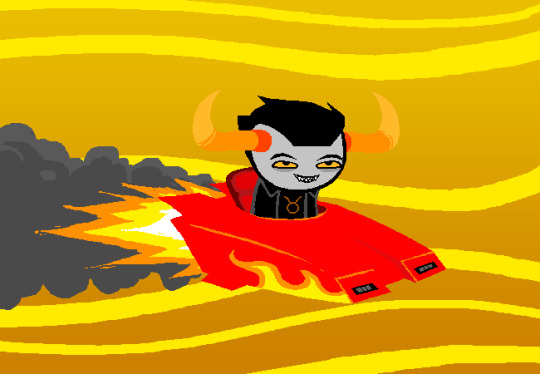
CHEL: Awww!
Tavros flies up to the Gate, and we cut back to him later on, leading an entourage of communed-with imps and ogres to move obstacles and help him solve puzzles. Using his skills well, I see! In another set of ruins the imps load jigsaw pieces of rock into a frog-shaped alcove,
Things, however, don’t continue to go so well, because Hussie hates this poor kid. I do not mean that facetiously. Statements he’s made elsewhere imply he has a hell of a lot of contempt for several of the characters he created, which I don’t understand at all. We’ll go into this after Act 7, but I get the sensation that the characters are merely tools to show off the complexity and meta references, which are the parts he really cares about.
BRIGHT: It’s not unknown for authors to dislike characters they wrote; the great Terry Pratchett reputedly hated his character Rincewind. The key difference is that in Pratchett’s case, the audience couldn’t tell. Hussie, on the other hand, tends to make his disdain pretty obvious, to the detriment of the story.
CHEL: That’s a point. Conan Doyle grew to hate Sherlock Holmes, too. He didn’t, however, set up situations solely to shit on Holmes in his books.
BRIGHT: I think that’s the key. I’ll forgive a multitude of failings as long as the author seems to be treating the characters fairly. That doesn’t mean that good things have to happen to them — plenty of bad things can happen and I’ll enjoy it — it just means that the author has to...respect how the character feels and would behave, I guess.
Of course, respect is Hussie’s antithesis, so.
Also, nothing so far has shown Vriska to be anything other than a (granted, entertaining) bully. I wasn’t around while Homestuck was updating, so I’m not sure when her fandom took off, but it has to be later than this, surely?
CHEL: I don’t know. I wasn’t around till about mid-Act 6.
What was I on about? Oh yes. Tavros is interrupted by Vriska again, who bitches him out for doing things the boring way and seeking the boring lore.
AG: The minds of your consorts are very soft and impressiona8le. AG: As easily manipul8ed as all those imps you've 8een 8ossing around. AG: I have picked apart their tiny little lizard 8rains and seen through all the smoke and mirrors of their riddles. AG: I have gotten to the truth they are guarding. The great 8ig mystery 8ehind this planet. And you know what it is, Tavros? AT: nO, AG: It's 8ullshit! AG: Meaningless, 8oring, fanciful 8ullshit wrapped in flowery poems to keep you guessing. AG: It all leads to one thing anyway, and that's what we should put our attention on. AG: Real gamers cut to the chase. They power through all the nonsense and go for the gold. AG: They cheat, Tavros. AG: It is time you learned to start cheating.
Interesting theory. Tavros thinks befriending his monsters instead of killing them is cheating, and Vriska grudgingly agrees but is annoyed he isn’t killing anything. She claims to have designed a better and more challenging quest for him; he asks after her own quest, and she says she has time because Kanaya’s busy.
AG: Which is just as well 8ecause I was starting to get nannied HARD. WHITE SBURB POSTMODERNISM: 37
Strange word choice for a species raised by animals, but okay. Vriska sends Tavros a map to the next Gate, and he sets off in his little rocket chair. Little does he know.
You proceed through what seems to be your second gate, into the LAND OF MAPS AND TREASURE. The THIEF OF LIGHT lies in wait.
In a callback to our last meeting of Breath and Light players, Tavros crashes through Vriska’s wall and is left hanging upside-down in the rocket chair from the large cobwebs across the room, while Vriska sleeps on a pile of broken eight-balls. Doesn’t look comfortable, but trolls rest in worse places later. Vriska wakes, and Tavros falls head-first onto the floor.
Here is where it gets incredibly uncomfortable, and we have to show it in detail to assign points properly and so that there’s no ambiguity about what’s happening, so if you have any sexual assault, ableism, underage, mind control, or victim-blaming triggers you may want to skip this part. No clothing is removed but it’s very unpleasant to read and the attitude toward it is worse. Seriously, this is Taklamakan Zoo levels of bad.
(This heading below’s not part of the comic, I just put it there so you can skip. The sequence ends with the piece of fanart of Kanaya looking at the sideways screen.)
~*THE ASSAULT STARTS HERE*~
Vriska sits up. She’s wearing a very short strappy white Tinkerbell dress with her sign on it, and what look like over-the-knee socks, a commonly fetishised style of clothing. I remind you these characters are supposed to be thirteen years old. The dress is also the same as the one worn by the fairy in the artwork on Tavros’ desktop background. I don’t know if Vriska had seen that or not.
FAILURE ARTIST:
To be fair she’s just in an actually-more-modest version of what Peter Pan’s sidekick/love interest wears and the socks come off as more dorky than sexy.
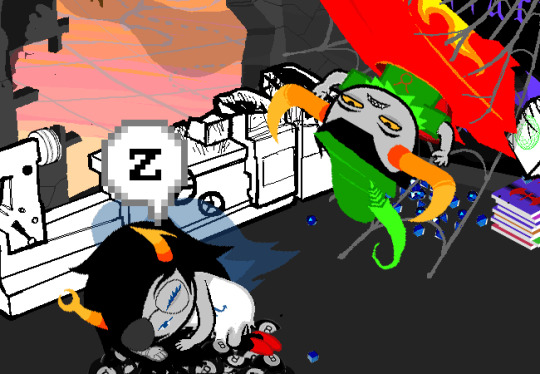
Oh my! It appears Pupa Pan himself has flown through your window while you were asleep. How exciting! Surely he is here to take you away on the adventure of a lifetime. He is more dreamy and heroic than you ever imagined. But what's this?? It seems the legendary Boy-Skylark has misplaced his shadow. He is looking EVERYWHERE for it, to no avail. He is having a devil of a time, what with being paralyzed from the waist down and all. He clearly needs your help.
CHEL: Vriska is prompted to Help Pupa find shadow, and approaches Tavros with a nasty-looking grin on her face, while he lies on the floor, gritting his teeth in noticeable pain.
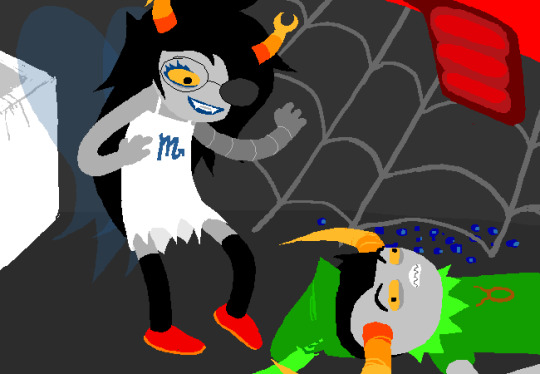
Pupa! You truly are a silly goose. Your shadow has been trapped underneath your useless torso the whole time! Honestly, where else would it be you stupid sack of shit?
Charming. Vriska proceeds to kick him in the head, or at least nudge him with her foot, while he lies unresponsive.
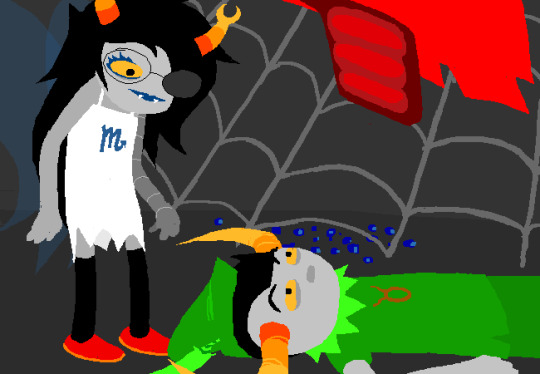
Of course, the secret to reuniting with your shadow is to get up and walk around. And play and dance and frolic! Your shadow will surely join in your gaiety. But it appears Pupa has lost the use of his legs. There will be no frolicking in this young man's future. ::::( Unless...
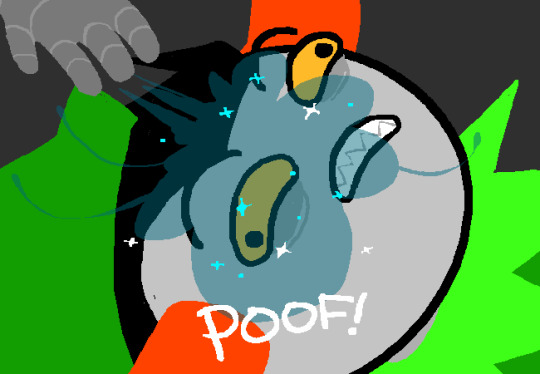
Everyone knows that just a pinch of SPECIAL STARDUST along with a happy thought will allow any boy to get up and walk again. Everyone knows this because it is in the classic tale, PUPA PAN. Young Pupa flies through the window of a fairy girl's respiteblock, falls on the floor, and has trouble getting up like an enormous pansy. The fairy girl then helps him walk again, and in return, he teaches her to fly, even though she probably already knows how to fly. Because she's a fairy. They fly out of her window together, and have magical adventures for many sweeps thereafter. To be honest, you hardly know a damn thing about Pupa Pan. But you do not care.
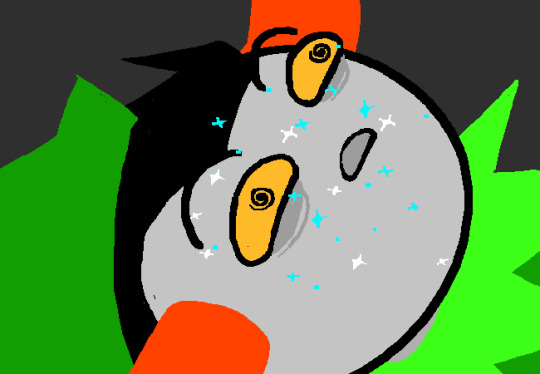
Pupa remains as pathetic and useless as ever.
FAILURE ARTIST: The story just keeps mocking Tavros for being disabled.
CHEL: Not to mention for being interested in fairies. Because how dare a boy have a gender-nonstandard interest, or a young teenager enjoy whimsical escapism from an increasingly horrible and guaranteed-to-be-short life.
WHITE SBURB POSTMODERNISM: 39
I might be projecting because the fandom has made me loathe her, but it honestly comes off like Vriska dressed up like this in the first place less to seduce Tavros and more to make sure she thoroughly ruined his favourite thing to hurt him further, especially if the narration is supposed to be things she’s actually saying to him.
The stardust did nothing! Probably because it is just glittery powder with no magical properties whatsoever and is basically bullshit. Because in case it wasn't clear, magic isn't real, and neither are miracles. OR It could just be that Pupa has failed to have a happy thought! Your duty is clear. You will have to MAKE him have happy thoughts. Vriska: Make Pupa have happy thoughts.
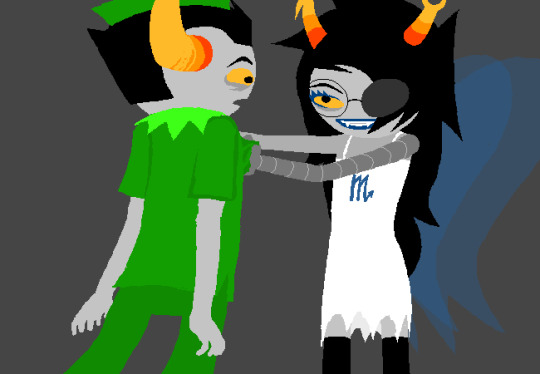
He certainly doesn’t seem to be having happy thoughts now. Notice his expression, what we can see of it, looks terrified, he’s trembling, and let’s recall that he’s paralysed from the waist down. Even if he wasn’t, she’s of a far, far higher caste than him, legally permitted to do whatever she wants to him, including killing him if he tries to resist. It’s kind of gone back and forth on, but higher bloods are a few times stated to be a lot stronger than lower bloods, and if they work like humans, they’re in puberty right now, a time at which human girls tend to get taller and stronger sooner than boys. Again, it’s gone back and forth on, but a common interpretation is that female trolls are stronger than male trolls in general and/or have the social power advantage. Let’s also remember that, even if none of those factors apply, Vriska has mind control powers. There is no point here at which Tavros has the advantage, nothing he can use as leverage on her. She can do whatever the hell she wants, and she does.
BRIGHT: We’ve also been explicitly shown that Vriska has little to no respect for anyone else’s autonomy if she finds it inconvenient, and that Tavros is her favourite punching bag, and that his ability to stand up for himself when she gets going is extremely limited.

CHEL: Despite the odds stacked against him, Tavros struggles against the kiss forced on him, and when Vriska pushes him back, doesn’t respond with anything but a look of horror, though she appears to expect him to, as a flickering heart-spade with a question mark over it appears between them. I’m not sure whether that’s supposed to be the thought process of him or her or both.
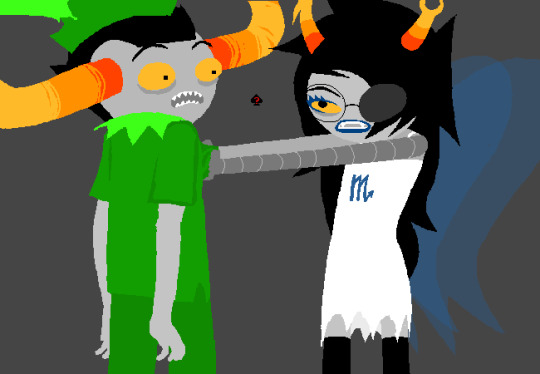
Vriska hurls him onto the floor with some force...
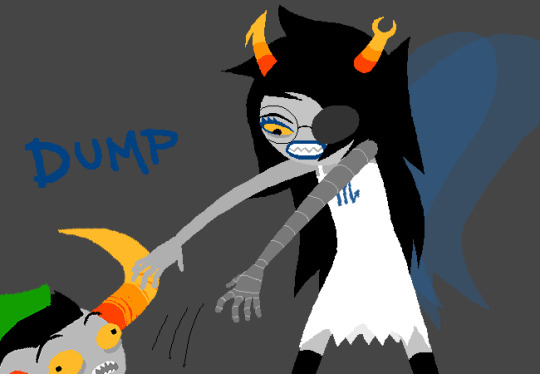
… and activates her mind control, causing little hearts to light up in Tavros’ eyes.
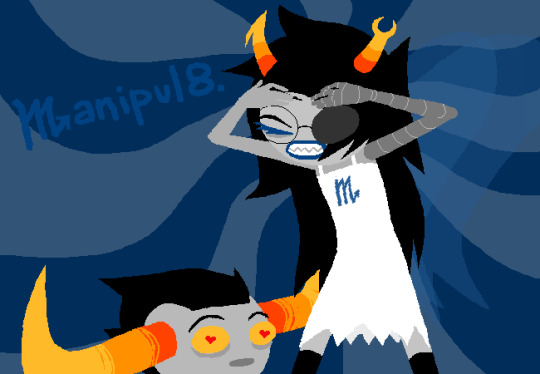
BRIGHT: Vriska has used her mind-control powers on Tavros before, and when it happened she walked him off a cliff. There is basically no way that her doing it again isn’t going to be a traumatic experience for him, above and beyond the inherent horror of losing control over one’s body.
I’m inclined to think that forcibly altering his emotions is worse, though. Being paralysed was bad enough, but Tavros knows what happened and he knows how he feels about it. Making him fall in love with her is just…on one level, it’s a horrible assault on his autonomy as a person, and on another level, it’s tailor-made to make him doubt himself and believe the encounter was something he wanted.
FAILURE ARTIST: I hadn’t thought that he might now consider the encounter as consensual, which would explain his later reaction.
CHEL: Tavros paws at her legs, making kissy faces, and she looks vaguely concerned. Note the background still depicts wavy blue rays coming off her, showing her power is still active.
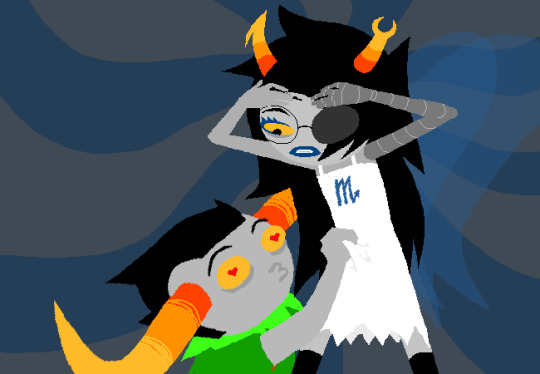
Looking defeated, she drops the control and dumps him on the floor again.
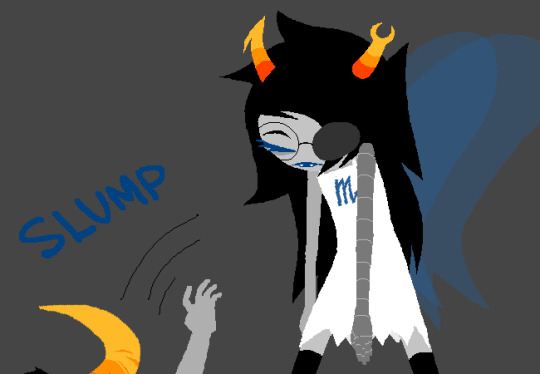
I’m not sure what she’s supposed to be thinking in this last panel. Is she feeling guilty? Is she disappointed that he didn’t like her under his own power? Has she just decided he’s too useless to be worth the effort? Any could be true.
BRIGHT: I read that as disappointment that even when he ‘liked’ her, he didn’t act the way she wanted. (And the way Tavros acted is kind of disturbing. ‘Mindlessly pawing at someone’ is not what I’d expect from him if he was legitimately attracted to someone.)
FAILURE ARTIST: The common interpretation these days was she was realizing she wasn’t into boys which okay that’s good for her but she should feel more bad about molesting him.
CHEL: That also makes no sense, because she shows interest in multiple boys later.
I’m also not entirely sure if Vriska had the intention of actually raping Tavros here (in the standard way, I mean, as one could argue that mind control is a form of rape), or just making out with him. The fact that she dressed up in vaguely fetishy clothing isn’t making it look good, though. Yes, she’s very young, but traumatised kids in particular have been known to lash out sexually like that. It’s a way of reasserting personal power, and I imagine it would be more prevalent in a society with no sapient adult supervision. While there are mitigating circumstances involved in their social situation and Vriska not really having ever had a chance to learn better, that doesn’t make this not a horrible thing to do, or not traumatising for Tavros.
BRIGHT: The clothing could potentially be down to Vriska wanting to look ‘adult’ without fully understanding why it looks adult. That does come up sometimes with teens — they want to experiment with clothing because that’s how adults dress, not because they want to look sexy, or they might dress a certain way for dates because that’s the social model they have for How Dates Work.
And if I read it like that, this basically looks like Vriska having the date equivalent of a dolls’ tea party. Which says volumes about how she views Tavros’s autonomy.
CHEL: Good point. Though honestly it would say volumes about same either way!
BRIGHT: I said earlier that Vriska is better than Equius at recognising when other people’s desires conflict with hers, and she is, but that doesn’t mean she respects those differences. She just recognises that they’re there, and overrides them. This is a prime example of Vriska viewing Tavros as something between a chew-toy and a prop. First she kicks him around and terrifies him, then she expects him to be able to get over those emotions at the drop of a hat and respond to her advances — and, moreover, she wants him to respond in a certain way, which Tavros has zero way of knowing. This is the first time she’s shown that sort of interest in him, unless her earlier behaviour was the Alternian equivalent of pigtail-pulling.
...I think maybe that was in fact Alternian pigtail-pulling. Or at least Vriska’s version of pigtail-pulling.
CHEL: That’ll actually make more sense, once we explain what the spade symbol means.
Okay, how many counts does this cover?
ALL THE LUCK: 12 ARE YOU TRYING TO BE FUNNY?: 31 CALL CPA PLEASE: 26 CLOCKWORK PROBLEMATYKKS: 55 IN HATE WITH MY CREATION: 13
It also occurred to me during this sequence to think again about how Karkat contemptuously swears at and hangs up the phone on the injured Tavros. This, at first glance, seems to be very much at odds with the “cranky but caring” impression we’re supposed to have of Karkat… but it fits precisely with Hussie’s opinion of Tavros and how pathetic he is for allowing a much more powerful person to permanently disable him. I know at the moment it looks like I’m not separating the character from the author, but it’ll become clear as we go that that is what he thinks.
IN HATE WITH MY CREATION: 14
Why didn’t we start a FUCK YOU, HUSSIE count?
BRIGHT: It would have ended up longer than all the other counts combined.
CHEL: The actual assault is over now, but there’s one more picture of it. The ramifications must continue to be discussed, so tread cautiously. The actual act is over now, though.
Said ramifications come pretty quickly. Kanaya, having dealt with getting herself into the game and prototyped her own lususprite, decides to check on Vriska.
Ideally she has not gotten herself into too much trouble. And ideally the dramatic irony has not gotten so thick you could draw a dotted line on it with a tube of lipstick and cut it in half with a chainsaw.
Of course, she sees the exact moment Vriska kisses Tavros.
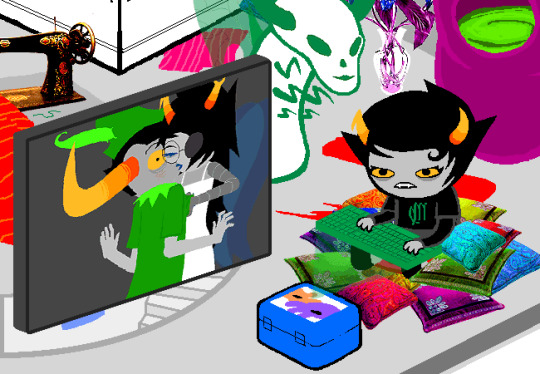
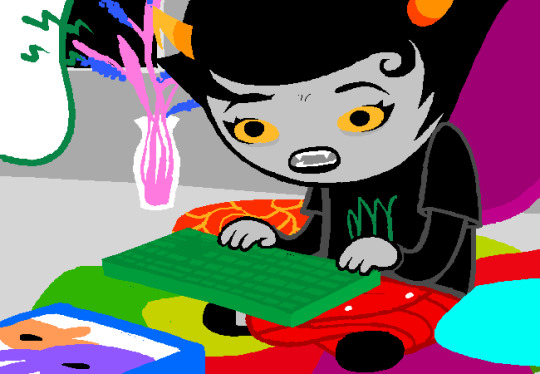
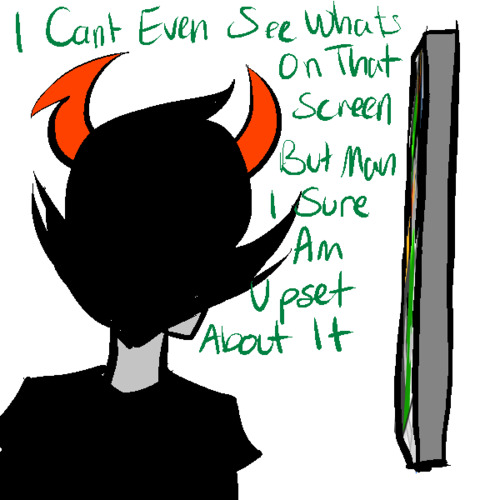
(Fanart source has now been deleted, sadly.)
~*THE ASSAULT ENDS HERE*~
Humorous art aside over, let’s watch Kanaya’s reaction in more detail. She angrily looks at a copy of the Tinkerbell dress, which she presumably sent the alchemiter code for rather than the actual item to Vriska, hence why she still has it.
So THAT'S why she had you make this dress for her??? And you just went along with it like a sucker. Argh, you are such an IDIOT!!!!!!!!!!!!!!!!!!
Like Karkat, Kanaya is presented as the caring one, the protective one. The “mom friend” of the group. And yet, she looks at this, in which Tavros is clearly frightened and struggling, and her reaction is to be mad that Vriska didn’t want to wear the dress for a date with her. I’m not sure whether this says more about Hussie’s opinion of Tavros or the social system of Alternia or both, but it certainly says a lot.
CLOCKWORK PROBLEMATYKKS: 56 HURRY UP AND DO NOTHING: 13 IN HATE WITH MY CREATION: 15
BRIGHT: Kanaya has had to corral Vriska on Tavros’s behalf already! Possibly more than once! She has all the information to realise that this is abusive, even leaving aside Tavros’s reaction! Sure, teens can be self-centred, but even so this is egregious.
CHEL: Kanaya’s Grubsprite comforts her and she throws the dress out the window.
Being a kid and growing up. It's hard and nobody understands.
Yes, I’m sure Tavros thinks so too.
Charles: "I know Sir can be prickly, but you have to understand he had a very terrible childhood."
Klaus: "I understand. I'm having a very terrible childhood right now."
-A Series of Unfortunate Events
6 notes
·
View notes
Text
Blog Post 3
1. If ‘Social justice is about making society function better – providing the support and tools to help turn lives around’ (UK Gov.co.uk), how well do you think the UK is achieving this today? What role can drama or theatre play in this?
In this chapter, Freebody begins by explaining the way social mobility is currently at an all-time low, with citizens struggling like never before to make their way up the social ladder. This is a consequence of the neo-liberal attitudes and concentration of wealth which seems to be dominating society (Freebody, 2015). Moreover, within this chapter, Barry analyses the way in which ‘extremist neoconservative views’ (Barry, 2005) dominate media outlets. This is an issue which has worsened in recent years due to the high extent of private ownership of these media outlets. According to Barry, as a result of this, ideas within the media often ‘epitomize mono-logical and fear-mongering propaganda’ (Barry, 2005) yet are passed off as factual news. This subsequently challenges the aims of social justice as the sources of information to which we rely on cannot be trusted and maintain a neoliberal agenda. This leads me to believe that the UK is currently failing to achieve social justice. This is reinforced further by the neoliberal values possessed by the UK government which tends to maintain a politically right leaning stance. An example of this being the fact that the privatization the NHS has been in talks amongst the Conservative party for some time now. This challenges the notion of social justice as it neglects a considerable percentage of the population who are less likely to be able to afford adequate healthcare and prioritizes the values of the upper class.
Theatre is able to play a role which helps promote the notion of social justice and everything it entails. Firstly, it is undeniable that there is a vast amount of theatre companies who set out to create social change in a variety of different contexts, for example, as Cardboard Citizens do with homelessness. This chapter emphasizes the way in which this types of theatre requires a process of considerable collectivity and cooperation from those involved. Freebody argues that working as a collective ‘may establish political togetherness in the wider public sphere’ (Freebody, 2015) which is reinforced by Richard Sennett’s suggestion that cooperation skills developed in drama can attribute to ‘complex cooperation’ in later life (Sennett, 2012) which challenges neoliberal attitudes.
Moreover, the element of imagination, which is a key element of drama, is emphasized as crucial in regards to increasing social justice within wider society. To elaborate, drama allows us to use imagination through visualizing a way forward and out of a society which is dominated by neoliberal values. A key example of this is Boal’s, Theatre of the Oppressed, which consists of audience members playing an active role in improving the circumstances of a play (much of the time this consists of applying social justice). This then provides an opportunity for spectators to apply modifications to their reality, just as they did with the play at hand, in order to work towards a more socially just society. To reinforce this notion, when referring to capitalist values which dominate society, Max Haiven stated, ‘without the radicalization of imagination, we have no hope of overcoming these crisis’ (Haiven, 2012).
2. Gallagher states that some of the young people that they studied seemed to have internalized robust neoliberal messages, taking full responsibility for their social and economic struggles. In what ways do you think this might apply to you in the context of your life and your third level study of drama?
I feel as though I am at the point in my life where I am having to dip my toe into adulthood and, frankly, I hate it. For me, my most predominant anxiety as I enter into this new stage of my life is finance. Since moving into a student house, I have had a taste of the responsibility of playing bills and rent etc, which are just small attributes of the seemingly endless yet inevitable list of financial burdens you have as an adult. Therefore, I completely understand how this way of thinking (which I feel is very common) leads to young people developing neoliberal attitudes in the hope of securing some kind of reassurance that they will be able to cover their own back as they enter adulthood.
Freebody reinforces this through depicting the neoliberal agenda as an attempt of young people to ‘minimize the humiliation and powerlessness they must feel, living at the economic edge of their communities’ (Freebody, 2015). Speaking on my own behalf, I am not from a particularly wealthy background and empathize with this feeling of being ‘at the economic edge’ of my community and wanting to do all I can to support myself and set myself up well for the future.
I do feel as though drama assists me in diverting any kind of neoliberal attitudes which I may begin to subconsciously develop. Being in favour of social justice myself, a neoliberal attitude is something I would actively want to resist and I feel drama assists me in doing so. Drama can be incredibly collaborative and, because of this, I feel it possesses an element of intimacy. It provides you with opportunities to hear about the personal experiences and deepest thoughts of those you work with. From personal experience, this can act as a barrier when it comes to getting wrapped up in one’s own life and problems and allows you to see the bigger picture and put things into perspective. This is reinforced by Freebody, as she states, ‘drama has always been about our sociality individual experiences of pleasure or sorrow, belonging or exclusion, are understood as relational. How we imagine, together, all the messiness and challenge of that, is what is at the very heart of what work we do’ (Freebody, 2015). I feel as though this component of drama is one that I will take with be beyond university and consciously maintain throughout my life in order to keep neoliberal attitudes, which seem to be so common amongst young people, at bay.
3. Describe in your own words what ecological thinking means?
Ecological thinking, in the context of social justice, refers to the way in which theatre can trigger our imaginations to consider how we, ourselves, can contribute to social justice. By participating in, or observing socially driven theatre, this can cause our minds to question various changes that we can make to ourselves or our environments to achieve a more socially just society. I have already explained the concept of Boal’s Theatre of the Oppressed with is a great example of how participants or spectators are encouraged to consider modifications to a performance in order to achieve a more socially just outcome. This way of thinking being applied to our own lives is a representation of ecological thinking.
4. Can you think of when you first became aware of or interested in social justice? Are there any specific things you do in your life that contribute to the notion of a just society for all?
With my mum being visually impaired and my dad working professionally within the sensory industry for as long as I can remember, social justice surrounding disability is something that I hold close to my heart. Due to her disability, my mum has been involved with various sight loss charities over the years and, prior to retiring, my dad was head of a sight loss charity which providing support and a plethora of services for the visually impaired, along with spreading awareness. Growing up, I spent copious amounts of time at dad’s workplace and formed relationships with members of the charity. In addition to our mother’s disability, this unknowingly provided myself and my siblings with an awareness of methods used within local communities to gain social justice for the disabled.
From the ages of twelve to sixteen, I volunteered at an animal rescue centre. Through caring for disadvantaged animals and working in ways to spread awareness for animal cruelty, this provided me with experience in trying to achieve social justice for a vulnerable group, who are without a voice themselves. The harsh treatment of some animals can be so saddening. However, what’s just as sad is the way in which animals which are slightly older or perhaps slightly more timid (usually as a result of their trauma) were rarely considered for homes over younger animals with bold personalities. This gave me an insight into how crucial social justice is for all animals due to the significant amount of mistreatment which goes on, as well as those who are discriminated against for not fitting society’s idea of the perfect pet.
Additionally, when I was eighteen, I spent some time volunteering for a homeless charity in my local community. Through speaking with other volunteers about their experiences with the charity and those themselves who were homeless, I gained an insight into lives which were so much less fortunate than mine. I feel this experience helped me develop more empathy and compassion as, after hearing the stories of these people, I found it easier to put the minor difficulties in my own life into perspective. Furthermore, I was able to gain an insight into the harsh treatments these people face from the rest of society as a result of the negative stereotypes surrounding homelessness. This provided me with an awareness of how crucial social justice is for groups such as this one.
Reference List
Freebody, K. (2015) Drama and social justice: theory, research and practice in international contexts. London: Routledge.
Barry, B. (2005) Why social justice matters. Cambridge, UK: Polity Press.
Sennett, R. (2012) Together: the rituals, pleasure and politics of cooperation. New Haven, CT: Yale University Press.
Haiven, M. (2012) Crises of imagination, crises of power: capitalism, creativity and the commons. London and New York: Zed Books.
0 notes
Text
Who watches the Watchmen?
Different types of power to think about - State Power; Social Power; Economic Power.
What is power? Control - key elements; manipulation; influence (a slightly less aggressive form of manipulation); - refers to a group of people’s values and beliefs (ideas, beliefs and values)
Characteristics? Wealth; Religion (Ideology); Monarchy - symbolic value;
Art? Creates discussion - addresses some imbalances, shows itself when one is pushed down by others the haves and have nots etc; Activists representing new ideas through various formats of Arts; Protest - resistance - proposing new ideas; Historical Marker - through the history of time across borders etc.
What is power?
Establishment; Business; Politics; State; Law; Banking; Police, Elite; Civil Service; Church; Media; Wealth; Monarchy and Education - various forms of institutions able to exercise power over people.
Forms of Power
State Power
Authority
Wealth
Education - under popular discussion re private schooling or shared resources
Influence
Race
Gender Patriarchy (Male) / (Hedgimany) Feminists
Sexuality
Wealth has its own privileges and sexuality being a dominant party. How factors/theories relating to the individual affect own practice.
How does art address this? Provoking people - Satire - “Vice” film shows good examples of seeking challenge structures of power about people without account making decisions about others’ lives about Politics and Power relating to the Iraq war. Collodud poem influencing Trump’s campaign - advisor changed the meaning about who should and should not enter the country.
Do you have a media platform? This could show manifestations of power.
Theorists of Power
Michael Foucault - a writer 1960s - 1990s interested in histories of ideas and looked at language within the structure of power - history of sexuality - looking at the way dominant class people oppress others and identifying as a gay man he figured how the systems were created to silence him. Through understanding Hetrodominance and how the reproductive sex has come to infect the main as to what can constitute a loving relationship, you can see how a lot of people would be excluded from that by the choices people make in life.
Foucault looked at Early 20th Century theorists to base his work on.
“It’s my hypothesis that the individual is not a pre-given entity which is seized on by the exercise of power. The individual, with his identity and characteristics, is the product of a relation of power exercised over bodies, multiplicities, movements, desires, forces.” (Michael Foucault)
What does he mean by the exercise of power?
Essential personality - untouched by anyone else - he believes there are forces that shape our ideas such as factors - absorbing/resisting parents ideas - Foucault believes the idea of pure untainted self doesn’t exist is influenced by relations of power that are exercised over our bodies - by basically delegitimising himself as a gay man that demonstrates an exercise of power. Everything affects us as a person. Do you believe? Resist?
Foucault’s Panopticon (an old french style prison system where there is a tower in the centre of the room, all the prisoners are around the outside with a single-window facing inwards, the tower has windows all around facing outwards. The theory is that takes one person in the tower to control the entire prison, from a fear of being watched) - from a book called Discipline & Punish where he talks about the history of the prison system. Gives a way of thinking through the elements of the current media landscape.
*If you throw in the element of two-way glass - it demonstrates how power becomes the apprehension of authority - rules and conducts that govern our lives - social norms etc.
Discipline power is exercised through its invisibility and the apprehension of power. The acknowledge and follow certain social regulations because we may be watched. The arts have started to address this. Seen, Shoen and Manifested. Graffiti has been brought to life by Banksy; Fashion offers us space to express who we are as an act of defiance. We can challenge ideas of power. Ideas Cameras, Surveillance are all key to current ideas and thought about how this may work. What data may be shared.
Imagine the internet as the tower in the middle of the prison how that impacts everything we do. Show how invisible force conditions our behaviour. How today’s life revolves around the internet.
Visibility is key.
Love Island is a dating show - unfeasibly beautiful people constantly surveyed by a big brother type machinery which follows their every move - and becoming a couple with fame, glory and money. Panopticon!!
Power? Fun to watch (surveillance); psychological ruin; you can watch and control them- and think you have the upper hand, but often they may win the upper hand. Reality television - not real - fake and very commercial. Making money for the television company and they often determine exactly who you will and will not like from the off. Beauty standards are very antiquated ideas no queers; obese or plain people. Very synthetic set to create paradise! Shows how gender can play a role in power.
Michael Cunningham - “Everything in the world is about sex except sex. Sex is about power.” Again, brings back to Love Island! Mechanisms and how power manifests others.
Foucault says, “ Power manifests itself in lots of ways and conditions who we are as subjects.” He said “If one had to speak of sex, one had to speak publicly in a manner that was not determined by the division between licit and illicit even if the speaker maintained the distinction for himself. One had to speak of it as a thing to be not simply condemned or tolerated but managed in certain of the systems of fertility regulated for the greater good of all the made to function according to an optimum. Sex was not something one simply judged it was something one administered.” Foucault implies that sex is a discursive instrument and the development of dominant sexual examples or by social standards preferable sexual examples can have real-world impacts on peoples lives. What is the utility - reproductive sex - used to provide good sex?
He also acknowledges the foster the basis for reactions to the powers. “The appearance of 19th-century psychiatry ‘Dearest Prudence” and literature of a whole series of discourses on species and subspecies of homosexuality in version pederasty and psychic hermaphroditism made possible a strong advance of social controls into this area of perversity but it also made possible the formation of a reverse discourse. Homosexuality began to speak on its own behalf to demand that its legitimacy or naturality be acknowledged often in the same vocabulary using the same categories that it was medically disqualified. - Trying to state it should be considered normal and not a perversion. If you continue to say, someone, they do not exist they eventually will rebel, as they do exist. It can also affect their mental state. Especially as controllers may believe that others will “bounce back”. It can be about creating discourses of resistance. You can bring on awareness of some movement bringing on changes which would affect others.
Theorising Gender. - Simon De Bouvoir, a Feminist wrote The Second Sex, 1949 - you have a choice to agree or disagree. It was a game-changer - what does it mean to be a woman? It created lots of revisions and people pushing against her as her conception of people being binary, your talking about specific women, not all women. She helped to pave the way for the feminine discourse. This preceded a lot of civil rights movements in the 1960s - black folk in America being the most visible - but there are lots of other civil rights movements. She talks about the myth of the woman and how people determine who others are by the way they exert power. “few myths have been more advantageous to the ruling caste than the myth of women: It justifies all privileges and even authorizes their abuse.” The Myth of women shows that genders have biological characteristics in their personality. i.e. old men are irrational, and women are emotional - these kinds of statements will put people down and make them feel inferior or ashamed. The woman’s place is in the home. Men needn’t bother themselves with alleviating themselves with the pains and burdens of physiologically of woman’s lot since these are intended by nature, it’s the way it is described as women’s natural consequences. 3-400 years ago, all written documentation about women was written by men - ideas of the natural woman came from those that were not a woman! Men then used this further by refusing to grant women any sexual pleasure and making her work like a beast of burden! Bouvoir is trying to say give people the freedom of choice to be whatever they want.
Specific ideas of Myths of women as a social construct include Princesses; Love Island; Mothers; Hip Hop singers etc. All of them are determined by men about women.
Judith Butler wrote Gender Trouble 1990 - talks about the distinction between male and female - is there a problem with that? Ties in with Foucault. Are individuals who do not identify as male or female wrong and do we press our judgement on to them? Butler says to think more fluidly, and variance does exist. What is dominance? I.e. What is right? If it is the majority, it is not necessarily correct nor is it the only way of living. “Gender is not something that one is it something that one does. It is an act (Key Point), a doing rather than a being. There is no gender identity behind the expressions of gender identity (What you choose to wear, physical image, what you do)” Gender is very flippant - i.e girls do this; boys do this etc.
Butler also relates to David Bowie; Prince is good examples of demonstrating arbitrariness they are masculine but very effeminate in their looks. Society constructs gender within clothes; biological factors; gender expression; generations allow for inheritance. Butler says people should be allowed to express themselves, individuals. Legal requirements also need to be adhered to.
Power and Race - Kwame Anthony Appiah, an Oxford philosopher, wrote Race. Current affairs and Political tendency’s - Race and ethnicity - white = race; British = ethnicity.
“Differences among people like differences among communities with a single society play a central role in our thinking about who we are - in structuring our values, (ideology) and in determining the identities in which we live. In the last century and a half, racialism and nationalism (think about how they both coincide with one another), so often bound together that one can hardly tell them apart, have played a central role about how we think about these differences and since one of the contributions of modern nationalism has been to see literature as central to national life, race has been central to literature and thought about literature throughout the period.” Literature is about Art - the whitewashing of any art scene you can see how these have cross applications as well. I.e. white actors play black characters. This demonstrates the particular powers of privileges operating within the film industry.
How do Race and Power intersect with the arts - procreation - while artists drawing from black culture and using it as an innovative idea? It has a different role to playing despite the fact that others have done this for years. Things like censorship and expose come out as well. Who are the artists? Who do you refer to for points of reference? What art movements? Who do they represent? Do they want to explore ideas of forms?
Where did ideas come from? The story of O.J. - Jay z 2017 - Street rap music became the push back at establishments 1970-1980 white America was leaving young black men as though they were criminals, and no one would employ them - what did they do?
Jay Z used cuts of overtly racialised animations caricatures to add to the message. In 1940s animations the similar imagery came up. Artists, illustrators and animators who draw others have the power to impress on others how one sees the individual. Although Jay Z is a black artist in 1930s it was not a black artist, therefore, it was how the white artist wanted to portray the black individual.
What De Bouvoir really talks about is an opportunity and how you could bring something innovative from your field similar to Virginia Wolfe’s - Room of One’s Own - what women need to create great literature is the opportunity to do so. Space and financial freedom to make one’s art. Historically women have not had this. She relates to “Daddy’s Office” - the father gets a workspace whereas the mother does not have this luxury.
De Bouvoir talks about Freedom - the freedom to produce “Indeed for one to become a creator, it is not enough to be cultivated that is to make going to shows and meeting people part of one’s life. Culture must be apprehended and taken through the free movement of the transcendents. The spirits with all its riches must project itself in an empty sky that is its to fill. But if a thousand fine bonds are tied to the earth its surge is broken. Etc.”
Take the sentiment that people should be allowed the freedom to explore who they are and produce art. Apply it is everyone, class, wealth and ability, gender, race, age, etc. Literariness a series of letters written from a boy to his mother who cannot read. Explores the strength they have through literariness. Thinking about the role that Art plays. There are ways of resisting these structures and they do not have to be adhered to without question should you wish to do so.
Resistant Art- Childish Gambino - viral sensation and what that does to the role you play in history. Do viral things remain?
The Weather Project - photograph - the people are the audience observing the simulated sun in a locked room - questions of the environment and the sun being the ultimate source of power. Climate change.
The Blindfolded Man - brings to mind political situations. Police brutality in America.
Does it have to be political or resistant? It can be realistic and show the persons’ ideal image. Realistic - what is visible around the world. Art & realism are difficult to think through together. Subject to a lot of forces that will affect it. Documentaries are believed to be factual but can still be very political. Personal can still be political. Great art perseveres i.e. Shakespeare plays. Although people still wish to adapt and alter to modern-day, elements and themes will persist.
What is Art? Why is it of interest? Personal, Subjective and allow for criticism and political scrutinise.
0 notes
Text
REFLECTIONS – chapter 30, 31 and 40
Selected global issues discussed in the chapters-
IMAGINATION & IDENTITY
Chapter 30, which is a part of the larger section titled ‘Night’, is an exploration of Offred’s past memories. The night, in the life of a handmaid, is the only part of their day they have reserved for themselves. While secluded in the privacy of her own room, Offred drifts away in her own thoughts, randomly appearing her head. The darkness of night also allows brings up the poetic language used by the narrator. It seems as if during the harsh sunlight of the day, Offred can not allow for her imagination to affect the way she perceives her surroundings, but once the sun sets, and night falls (a vivid discussion at the beginning of the chapter regarding why it falls rather than lifts is a sign of this sudden creativity emerging from the narrator as well), Offred becomes more focused on her senses and imagination, and uses rhetorical devices or imagery to deepen the readers understanding of her current state. She allows her thoughts to be free at night, therefore after spending the whole day submissively, her internal monologue cannot stop resurfacing events from the past, all of which are loosely tied to each other. Only through these memories can Offred sustain her identity. After her entire life has ended, she clings on to her remembrance of the past. Her collective memories form her identity.
BELIEFS & VALUES
As she relives events from the past, such as the day her and her husband had to make the decision to kill their cat, Offred evaluates her thoughts regarding how the communal oppression affected ones moral rules, and set of beliefs. Once her and her husband are forced to flee the country as a means of survival, the couple realize they cannot abandon their cat, as her aimless wandering may give them away to the authorities. ‘’I’ll take care of it, Luke said. And because he said it, instead of her, I knew he meant kill.” In order to be capable of killing anyone, one must first deprive it of its humanity – dehumanizing it. Luke had to see their cat as an object, and obstacle standing in the way of their freedom in order to even physically be able to murder it. This comparably small event forms a parallel between the current Gileadean society, where every citizen is regarded to without consideration for their life. Almost as if they were pions used for achieving a larger goal, which is the survival of the human race. But what is striking in this unwavering mentality, is that the aim of continuing the human population is achieved through taking away the humanity of the people. Offred states –‘’they force you to kill within yourself”, suggesting that once in the eyes of anybody or anything, one become a statistic rather than a person, they may come to think of themselves in that manner as well, therefore killing their humanity themselves.
Beliefs in the terms of religion are also explored in this chapter, as it reaches it’s end with Offred’s prayer. Before starting, she has a flashback from when she was forced to harmoniously pray along with the other women in the Red Centre. The verse ‘’Thank you for not creating me a man” is a reference and reversal of a Jewish prayer during which men thank God for not creating them a woman. This allusion simultaneously adds irony to the text, as well as fulfills the role of emphasizing a social double standard. The idea that one should be thankful for not being a woman is already degrading toward the second sex. In the novel, the context in which Atwood places this phrase suggests that the reason why handmaidens should be thankful to be women, is because they can serve the men by bearing their children. Both the clauses are offensive towards women, but the reasons are completely different. However, in Offreds personal prayer, she leaves the formalities aside, and builds a more intimate bond with the God she is speaking to. “I wish you tell me Your name, the real one I mean.” The narrator implies that even God, who is ominously referred to by a single word, just like her, has an original name, one that has nothing in common with the function He has, or the role He plays. In her solitude, the narrator is overwhelmed with a sudden need for grounded intimacy. The prayer for Offred is a last retreat of sorts. She panics as it starts to end, terrified by the thought that perhaps her words have no listener and that indeed even at this moment she is alone. Unlike the prayers conducted at the Red Centre, Offred’s speech to God is purely her’s. She treats the concept of the prayer without its inherent sanctity, and allows herself this one moment of conversational relief.
COMMUNITY
By the start of chapter 31, which begins a new section titles ‘Jezebels’, Atwood comments on the social pressures imposed by the members of a community. She mentions ‘It should scratch makes on the wall, one for each day of the week […] but what would be the use, this isn’t a jail sentence’, thereby comparing her environment to a prison. Working further on this idea we can imagine all the inhabitants of the area are either prisoners or guards, and similarly to the community of a jailhouse, aside from the institutional laws, there are a set of social pressures created and regulated by the members of the oppressed community. An example of such an issue is Offred telling the time by the moon cycle, which consists of 28, the same number as that of a women’s menstrual cycle. Even though Offred opposes to the regime of the Eyes, in order to remain safe in her environment, she immediately associates the passage of time with her fertility. Another socially construct necessity is that for Serena to have a child. Of course the idea that she may genuinely want to have an offspring is anything but rules out, however by presenting Offred with the idea that if she wants to remain safe of the risk of becoming an Unwoman, she should consider disobeying the law and engaging in a sexual relationship with Nick, Serena must be somewhat influenced by how the other high-ranking Wives view her. The social pressures of the community become a larger factor than the actual set of rules regulated by the authorities and that are imposed on the people.
SEXUALITY & IDENTITY
Starting from chapter 30, Offred mentions her diminishing control over her own body and sexuality, nonetheless, it is in chapter 40 that these concerns become impersonated. In the previous chapter, Offred states –‘’my nightgown, long-sleeved even in the summer to keep us from the temptations of our own flesh, to keep us from hugging ourselves, bare-armed”. The clause indicates that women, specifically handmaids no longer have a right to their own body. The concept of sexuality is merely liquidated and urged to be forgotten, therefore, women are not even permitted to feel the touch of their own skin. Yet, this does not mean that one’s thoughts have to conform. ‘’They scent from the garden rises like a heat from a body’’, suggesting that it is against the nature of humankind to abolish sexuality. From an evolutionary standpoint, that trait is one of the reasons humans have survived this far, thus expecting that withholding temptation would be easier than withholding the urge to act or think is unrealistic.
The lack of human touch Offred has been struggling with manifests itself in chapter 40, when she arrives at Nicks door. There are two full versions of the events that took place in that room told by the narrator, nevertheless, both are said to be false. The various versions may lead to reader to question the reliability of the author. All being said, the Historical Notes section clearly indicates that since the narrator could not be traced, the events may fabricated. Yet the reason for the unclear string of events may be the emotional overload Offred faced upon entering the room. Offred’s statement “I am alive in my skin” is a clear suggestion that because of the lack of physical touch that narrator has experienced in the past years, the excitement that entails the experience may make the recollections more hazy and faded. False memories are also a factor worth considering, as from a psychological point of view, the sudden intimacy may have been a shock factor for the narrator, leading her to loose her grip on the objective reality and focus on her subjective experience. The final phrases – ‘’Is would like to be ignorant. Then I wouldn’t’ know how ignorant I was’’ means that the simple act of engaging in a sexual relationship, while Luke is still alive, is a burden on the narrator. She admits to needing love, nevertheless, cannot come to terms that she can somehow ‘replace’ her lost husband with Nick. This indicated that she regards her body and sexuality as something that has the possibility to belong to a certain person, rather then simply be hers. Later in the novel she explains that she loved Nick, and perhaps that is why she felt she had deceived Luke, yet at this moment, she is completely at loss with what her body is and who it belongs to.
0 notes
Text
Bulgarian Regimentation Of Morris Rosenberg's Self.
7 Ways gel Could Enhance Your Business. If you liked this article and you would like to collect more info regarding mouse click the up coming internet site kindly visit our site.
In these exclusive meetings, our team speak to DOCTOR Julio Frenk (Administrator from the Harvard School of Public Health, as well as previous Priest from Wellness of Mexico), Sir Richard Thompson (Head of state from the Royal College of Physicians), Baron Peter Piot (Supervisor of the Greater london School from Cleanliness and Tropical Medication) and also Dame Sally Davies (The UK's Chief Medical Policeman). Our team did this as part of Defy Ventures, an employment, character, and entrepreneurship progression instruction plan for currently and previously jailed males, girls, and also young people. Without summer knowing options, little ones would certainly come back to school behind or doing not have the expertise should face new difficulties and goals at the following grade amount. Sunday 16th Nov Just - Event Celebrations - Pep talk Blister Panel Location. We'll be revealing the victors survive on stage - and also they'll come to observe their job published in 2018's Thought and feelings Blister Compilation from Photo Comic books! Weili Dai I am actually a software application nerd, my spouse is components nerd, and also our company started our firm with the opinion that the DNA from business owners can help our team build much better innovation that could possibly make an actual effect.
Top 5 Trends In gel To View.
Some African leaders as well as their promoters perceive the court to be a supplement from imperialists bent on humiliate 'Africans'. On the incredibly concept of a Western side know-how heritage: Studying declarations that address financial regression in Africa. In the course of the past decade, these groups have likewise provided proof for illegal inspections right into abuse and also extrajudicial punishments in numerous nations - consisting of Colombia, Honduras, Libya, Mexico, Peru, and Sierra Leone - to make certain accountability for serious human rights offenses as well as mass wrongs. When business owners speak about their objective from being acquihired through a huge company, this pains me as an entrepreneur. Poor girls came to be entrepreneurs without education or even instruction. Hosted by Gender Institute, Middle East Centre and also LSE Literary Festivity. Nonetheless, the book recounts his expertises in Ghana throughout the nation's very first stroke of genius d'état in February 1966 which crushed Head of state Kwame Nkrumah, and the 'dropped years from Africa' in the 1980s and 1970s.
10 Simple facts That Nobody Distinguished You About gel.
The tip from guide was a culture that was developed around a maker that offered everybody, dealt with their needs, food as well as every thing else- someday, the device does not function. September denotes then when bags are actually dropped, brand-new fall jackets as well as school products are being actually purchased as well as little ones from every ages excitedly expect the year's adventures along with the brand-new academic year's schoolmates and also teachers. Through connecting like-minded associations, our experts tailor plans to fulfill the special requirements from each neighborhood our company offer. DOCTOR Shirin Ebadi War stays humanity's very most successful quality; and our team view that a lot of economic crises have actually been actually resolved via battle. I live in 4 little bit of containers ... Music, Gifting, Entrepreneurship and Tv. Without a doubt, these exclusionary tendencies have actually led to epistemic prejudice from Africa and Black theory (Graness, 2015 ), an incorrect performed to someone primarily in their ability as a knower" (Fricker, 2007, p. 1). Due to the fact that epistemic prejudice is manifested in patterns of silencing, amazement, or even misconception, the exclusion from a whole continent coming from the past from ideology is actually definitely a profound epistemic oppression which has to be actually fixed", said, the College from Vienna theorist, Graness (2015, p. 80). There have been many contact psycho therapists to indigenize their field in Africa as a whole (Andrews & Okpanachi, 2012; Builder & Kooistra, 2014; Nsamenang, 2007) as well as in Ghana specifically (Oppong Asante & Oppong, 2012; Oppong, Oppong Asante, & Kumaku, 2014; Oppong, 2013, 2016a ). Andrews and Okpanachi (2012, p. 85) made the point more highly when they suggested that African individuals must think artistically from within as well as generate knowledge that is a lot more in tune with an African situation rather than depending upon publications, concepts, and approaches from elsewhere". All incomes visit the Barnardo's Children's Charity. Montreal-based Drawn & Quarterly publisher of Julie Doucet, Kate Beaton, Chester Brown, Adrian Tomien and extra, joins our company at Thought Bubble for the very first time. Individuals's impression from the constructed environment is altering also, as a result experts (designers and also engineers alike) involved in developing and forming their built setting must readjust, conform or even entirely alter, if needed, to become able to answer and also understand their goals, perfects, suggestions as well as wishes.
0 notes
Text
Integrity as Art How do the artists Mairna Abramovic and Joseph Beuys interrogate honesty through a visual language? When considering communication through art, there is no doubt that by using it, artists aim to get across their views to the public. It may be questioned whether this is linked physiologically, but generally it results in achieving an emotion in the viewer; even if emotionless, this within it, is still an emotional response. In relevance to the emotional connection between artist and spectator, a relationship can also be established when taking into consideration the communication between private [artist] and public [spectator]. Homing into a selection of artists that trigger this connection, in distinct yet similar ways, the ones that stood out were Marina Abramovic and Joseph Beuys. By exploring the use of their theories and methods, this essay will explore the way the following artists provoke an emotional response in the viewers by only using their art. Marina Abramovic, sees performance as a mental and physical construction. Judging by her work, she aims to make people conscious. Working with emotions that create fear within people may at first come across as daunting and shocking, if not even insane, but when one looks deeper into her work, one soon comes to realise that there is a strong concept behind it all. It is then, when the audience may also realise that they can find these concepts relatable. For example, our current generation lives in such a fast-pace that one can easily forget the reality that surrounds them. There are many factors, which makes society overlook the importance of ourselves and the value of our feelings. The overload of school, work, responsibilities create a barrier to opening up and considering those true emotions that are extremely important for the human well-being. Marina Abramovic has opened centres and is leading projects that make people more cautious by using their time in a different way. She carries out exercises that involve prolonging time. For example, writing your name in the slowest possible way and drinking water so that you are able to take every sip consciously. These are some of the exercises. Abramovic’s work, acts as something more than just a visually pleasing piece put together that gets forgotten after being performed; it sticks to the spectator. It insinuates the idea of honesty because of the feelings that form with in. It is truly empowering because very rarely one is able to get deeply touched and is able to feel such emotions but through Marina Abramovic’s performances this happens.
In ‘The Artist Is Present’, Abramovic only sits and stares into the constantly changing members of the audience. A simple act, yet so powerful. One act, done daily, an act so habitual, and seemingly an act that has lost its powerful influence, but when changed in concept becomes something so overwhelming that it can even provoke tears in the audiences’ eyes. This is what shows honesty. The idea that something so small can create something so big.
In the aim to play around with the idea of consciousness, in her performance 'Rhythm 5 (1974)', Marina Abramovic had actually in the end lost her conscious. By demonstrating such bravery without the fear of later consequences, she leaps through the flames into the lit up five-pointed star for physical and mental purification. This can in no other way be interpreted but as an act of complete honestly and belief. She however, came to realise, that she had gone too far. She contemplated that ''when you lose consciousness you can’t be present, you can’t perform'' (1). Risking her life and her well-being, goes to show that once again, Marina Abramovic does not try to hide anything in her performance, and thus her emotions are genuine. She goes all the way. Would anyone risk their life just for a performance if did not believe in what they were doing? Her struggle through childhood penetrates when she speaks about her past. Growing up in communism and with strict parents, she demonstrates a desire for liberation through her work. Being detained from the freedom of going out and restricted from being who she fully wants to be, she longed for being able to express herself and so now she demonstrates this through her work. Her art seems revolutionary. Having an early night-time curfew even beyond the age of twenty-five brought an oppression within her and her own limits. Through Marina Abramovic’s art, it is clear to see that she performs with sincere emotions and feelings, with a want to break barriers. It is almost like a circular structure as she always remembers what the past has held, incorporating it into her performance to make it fulfil her true self, that she was never able to present before. Her work is extremely personal. She dares to experiment with ideas that she has never previously tried and this creates desire in the audience to expect her performance with anticipation. By experimenting with the unexpected and the unusual, Marina Abramovic shows that she wants to be freed from this burden. She aims to make a change. In general, some of the art created on a day-to-day basis looks monotonous and this does not provoke change and in addition it actually accounts for the desensitisation in the viewers. However, Marina Abramovic brings about a revolution by offering an alternative view upon art. She dwells into her performances, in search of this emotional relevance and connection. She uses pain as her tool to build her up. This creates a certain extent of irony because no one sees pain as a positive thing but also, more importantly, there is a contrast between the past and present as pain in her childhood was used to break her; however, now we see that it opposes this idea. This shows potential hope in her work, in helping people with their experiences. It almost seems like a spiritual rehabilitation. Actions in her past have also been deceived. Her grandmother, being an orthodox Christian, gathered the family together to celebrate Christmas. During this time, they were forced to cover up and black out their windows so that no one would understand that they believed in these religious traditions. If they were to be uncovered, they would have been killed and so this shows in what sort of a lying society people through communism used to live. It can be said that through Marina Abramovic’s work, we are able to see that she may be afraid yet she still continues in her actions because it reflects past events that seem to have remained. In her childhood Christianity was not meant to be practiced as it was imposed by the government. This is inhumane and unreal. It is discrimination. This seems like a form of getting rid of one’s identity, because religion is something spiritual. It almost rids the individual of being themselves and taking all that they look forward to. Marina is able to pass on emotions that she has experiences in her performance so that they can be felt by the public. She wants to show that people are also able to build themselves too. She imposes this idea that if one faces their fears, this will not make them fear more but in reverse, one will lose this fear and rid themselves of this emotional weight. This growth and building of her own self has been seen through her desire to break all boundaries and push the limits for her body and mind to the extent no one has before. ''In the theatre, the knife is not a knife and the blood is just ketchup. In the performance, the blood is the material, and the razor blade or knife is the tool. It's all about being there in the real time, and you can't rehearse performance, because you can't do many of these types of things twice -- ever. ''(2) this further highlights her surrounding reality. This shows that people should value life and live enjoying the small moments. She believes that being an artist is not a job, you don’t go home and all of sudden you change characters. And performing in such an influential way, displays her sincere emotions, and that she truly believes in what she is doing. So therefore now it may be questioned: how can something so strong not be interpreted as honest? It’s impossible.
If you are able to imagine how one will even try to explain to an animal a certain idea and for this animal to reach to the point of understanding, would you not interpret this as a step closer to insanity?
Well, Joseph Beuys' in his work 'How to Explain Pictures to a Dead Hare' does exactly this; he whispers to an animal carcass trying to explain his drawings. Beuys works examining the understanding of this hare and how the audience perceives the lesson that he gives him. Not only that the idea imposed, is somewhat impossible for the hare to fathom in a way that a person would, but to somewhat extent, it becomes comical when one comes to the realisation that the hare is actually dead. Considering that, this arrangement might have created humour within the audience, awareness is raised to contradict it and say that Beuys works with symbolism for all aspects in his performances, so this humour is slowly eliminated. And when a deeper thinking commences, it is then accepted as an intellectual challenge. This goes to say that all of the chosen elements are purposefully introduced, including the hare and specifically it being dead. It can be said that Beuys intentionally lacks direct explanation about his art, which shows truth, because silence is sometimes more real than speaking out words that could diminish the captivation of the piece or that could potentially be taken out of context. Beuys sticks to the concept behind his performances and debatably the outcomes seem to not be considered with greater importance. Beuys believes that ''objects aren’t very important anymore.'' and that he wants ''to get to the origin of matter, to the thought behind it." And this explains the chosen materials in the performance 'How to Explain Pictures to a Dead Hare'. ''Every item in the room - a wilting fir tree, the honey, the felt, and the fifty-dollars-worth of gold leaf - was chosen specifically for both its symbolic potential as well as its literal significance: honey for life, gold for wealth, hare as death, metal as conductor of invisible energies, felt as protection''(3), and more. Beuys aims to stage an understanding, displaying honesty through his actions. Sometimes there is a bigger importance in what we see rather than what we hear. The reason why Joseph Beuys searches for this understanding within the public is because he believes in political reform. Growing up during Hitler's rule he wanted positive change, and to achieve spiritual harmony. ''Beuys lectured on humanity’s innate creative capacity and the power of direct democracy to shape society.''(4) Through this he believed that working publicly and as one essence was the way forward, and this is so, even though he also stood up to individualism. He used ‘’politics as a medium by which to communicate a message about the revolutionary potential of art.’’ (5) He used his art to stem ideas that no one had dared to question let alone oppose politically. Through the following actions he displays his true intentions because serious consequences could have followed from stronger forces yet he still took on the risk. Political improvement is hard to make and history offers evidence, which proves that through the years, these different reforms have led to different causes. Through his art, Joseph Beuys aims to introduce an unorthodox manner of thinking. He even creates the phrase ‘social sculpture’ to expand concepts and the understanding of art’s potential in transforming society. He has involved concepts covering all spheres including social, cultural and political functions. It was previously said that the idea imposed, is somewhat impossible for the hare to fathom in a way that a person would, however, Beuys suggests that humanity and hares have more in common than one is able to imagine. He talks about the path of reincarnation and the way that hares, when reincarnated, their thinking is able to sharpen and transform and therefore become revolutionary because they have powers of intuition; this is a reflection of human beings as well however through their stubborn rationality its reforms become complex. For those who are willing to gain an inside look, beyond the overall appearance and the aesthetics of Beuys’ performance, there is potential to stimulate change so that such high-level art will be recognised genuinely. When the spectators free themselves from the form of their inbuilt systematic thinking, their imaginations can be stimulated, allowing them to transcend the standard and start to question art mysteriously. As a whole, conceptually Marina Abramovic tries to make people become conscious of themselves. She does this through the use of time, by slowing actions down and making people more aware of their interaction with them. Beuys on the other hand, wants to make people understand. They both use their emotional triggers to deliver their emotion to the public too. Interacting with the public, for Marina Abramovic forms a holistic art performance, whereas Joseph Beuys maybe sees himself as a teacher that can pass on his emotional beliefs and theories. Both achieve a level of connection. Most importantly, they appear honest. They both achieve honesty in their performances, in demonstration of their actions because the effect of the performance would not have enthralled the audience as much if they tried to present emotions that they themselves did not feel. As a whole, the honesty that Marina Abramovic shows is more verbal. She tells stories about her personal life because she felt that this was important for her art practice. This makes the people feel her closer as a person, almost as a friend. It gets personal. Her mature stability makes her seem like a figure that can be trusted. Joseph Beuys works through actions and allows interpretation to kick in. One has repeatedly heard the phrase actions are stronger than words, and this accounts for his work. Both artists Marina Abramovic and Joseph Beuys break the 'norms' of art and this may be due to their tough experiences in their childhood life. To conclude, Marina Abramovic and Joseph Beuys both using the power of performance, exhibit honesty in a successful way. Both Marina Abramovic and Joseph Beuys, use strong concepts that are interpreted by the audience and are assimilated with great thought and time. They confront the audience with challenges by facing them with suggestions about current issues. My work has been relevant to both Marina Abramovic and Joseph Beuys because of the sophistication it has gained when compared from the beginning. However, apart from analysing the aesthetics of my work, there has been a greater reasoning for why the works of these both artists link to my own. With most of the experiments that I overtook, there was a daunting feeling that came within which is what Marina Abramovic talks about with her experiments and this idea of the unknown. Also, my project having the theme of public and private, the experiments ended up being personal. This is seen in the shower experiments and the quotes that people had told me, that were written on my body. Marina’s art is extremely personal. With Joseph Beuys I believe that my work links in the way that I have not explained everything in the experiments that I have done. There is room for interpretation, and this is exactly what makes my project expand.
Bibliography (1) https://en.wikipedia.org/wiki/Marina_Abramović (2) https://www.ted.com/talks/marina_abramovic_an_art_made_of_trust_vulnerability_and_connection/transcript (3) https://eeacollins.wordpress.com/ (4) http://www.tate.org.uk/whats-on/tate-modern/display/artist-rooms-joseph-beuys-london/joseph-beuys-information-action (5) http://www.tandfonline.com/doi/abs/10.1080/17541328.2015.1043800?src=recsys&
0 notes
Photo
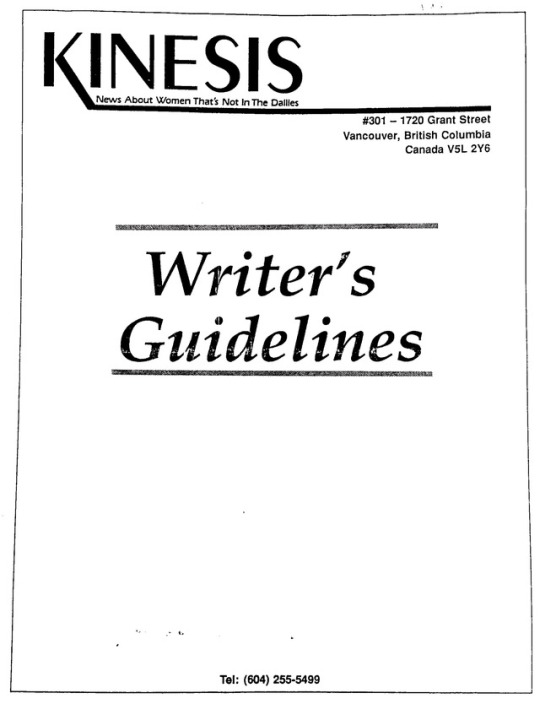
Kinesis: News About Women That’s Not In The Dailies, on language sensitivity and unbiased writing
The magazine Kinesis was published from 1974 to 2001 by the Vancouver Status of Women. It was founded during a particularly vibrant period of women’s self-publishing; periodicals and journals such as Makara, Off Our Backs, The Pedestal, The (Other) Woman, Pork Roast, The Rag and countless others became mainstays in Vancouver feminist communities, offering alternative sources for news that actively worked to disrupt media systems of oppression.
Beyond reporting on “news about women that’s not in the dailies,” they also provided female reporters with a platform to publish, and encouraged women without professional backgrounds to develop their journalism skills. In a 1985 handout titled “Kinesis Writers Guidelines” (which can now be found in the the Vancouver City Archives pamphlet collection), Kinesis outlined the process of submitting an article to be included for publication [1]. A particularly important section of that document is titled “Language and Bias Sensitivity Guide.”
Kinesis established an editorial framework which understood that writers have a responsibility to their representations of people. The english language, after all, can be considered a colonialist device, and -- like mostly anything in a patriarchal culture -- it is also overwrought with many naturalized biases [2].
The sensitivity guide details several subsections, including “Race and Culture,” “Class,” “Sexual Orientation,” “Disability,” and “Age and Appearance”. If Kinesis were still being published today, the list would likely have been updated to include more information on Indigenous Politics and Gender Identities, but the concepts present in the 1985 version are still hugely important introductions to the responsibilities of representation.
While hard copies of Kinesis can be found at both the SFU and UBC RBSC archives, the UBC Digitization Centre has made the UBC RBSC holdings available for online viewing [3]. The aforementioned “Language and Bias Sensitivity Guide” can be found transcribed in its entirety below.
LANGUAGE AND BIAS SENSITIVITY GUIDE
Introduction
Words are powerful. They can challenge stereotypes, overturn common assumptions and initiate the process of social change. They can also perpetuate sexist, racist, classist, ableist and homophobic attitudes.
Part of our work at Kinesis involves developing greater awareness of how our perspectives as writers -- even the words we choose -- are influenced by our cultural and class backgrounds. As feminist journalists, women at Kinesis have long been part of the collective process of rooting out, then changing, the sexism embedded in ordinary English usage. We no longer buy the idea that “mankind” is an inclusive term or that “girl” is a harmless way of describing a 40-year old women. [sic] In the same way, we are also in a process of discovering how language can reduce or make invisible the lives of people who don’t fit the stereotype of what is “good and normal.”
We present this guide as a work-in-progress: a brief description of some of the most common ways bias creeps into writing, along with some suggestions for change. Every woman who sits down to write is taking up a difficult, even scary, challenge. Many of us are unsure about our “voice” or are inclined to quickly self-censor. Our hope is that this guide will encourage women by triggering a new awareness about old ways of writing.
The blank page at the end of this section is for you to record any observations, questions or ideas you may have about bias in writing. Kinesis welcomes feedback and hopes that women will talk together about writing problems and solutions. Future versions of this work-in-progress will depend on your feedback.
Note: Kinesis has material on writing without bias which writers are welcome to borrow.
Race and Culture
Many words and phrases in English carry the weight of a history of racism. The words “white or light,” for example, are usually associated with goodness and purity, while “black or dark” are associated with negativity and evil. Similarly, a white lie is insignificant but a black lie is very serious. Writers can avoid reinforcing this kind of racism by choosing alternatives for words with negative, racially-related connotations. For example:
blacken…….....defame
black eye……..mark of shame
black hearted...malevolent
blackmail…......force, coerce
blacklist…..…...list of undesirables
black humour....bleak humour
Writers should take care not to assume that every issue or event affects every woman in the same way. Generalizations about women’s experience can obscure the different circumstances, priorities and analyses of specific groups of women. It would be inaccurate, for example, to write a story about reproductive rights as if choice on abortion were the most important issue. Although the white women’s movement may have focussed on abortion, for women of colour the abortion issue has been one part of a larger struggle which includes an end to sterilization abuse, population controls, birth experimentation etc.
Some of the terms used to describe colour, race and culture are so broad they convey very little. “Oriental,” for example, is a vague word that can refer to many different peoples. Writers can avoid over-generalizing by choosing more specific terms based on the country an individual comes from. The most appropriate terms are those that arise from each country or culture’s definition of itself.
Seemingly innocent words and phrases can reinforce ethnocentric viewpoints by making dominant white values and perceptions a standard. The word “minority,” for example, is frequently used to refer to people of colour, although, globally, people of colour are the majority and white people are the minority. Similarly, the phrase “visible minority” begs the question -- visible to whom? Writers can avoid the tendency to imply that white is the norm by choosing more accurate and informative phrases. Rather than “non-white,” for example, writers can use more specific terms such as Black, Native or South Asian.
Many of the terms used to distinguish between highly industrialized and less industrialized parts of the world carry subtle messages about the superiority of the industrialized world and, by implication, the superiority of white culture. These phrases include: “developing nations, underdeveloped nations, First, Second and Third world.” Consensus has not been reached about alternative terms, so writers should respect the words women choose to describe themselves.
People of colour are often presented as a burden to the rest of the world. Adjectives such as “poor, underdeveloped, backward, primitive, uncivilized, culturally deprived, and economically disadvantaged” reinforce that view. Writers can avoid feeding into this by presenting information in a positive way, making clear the initiatives people of colour have taken, the solutions they’ve found. For example, “Black people were given their freedom” suggests that Black people played a passive role in historical change. “Black people won their freedom” emphasizes the active role Black people played in their own liberation.
In general, try to be aware of the powerful and destructive influences imperialism and colonialism have had, and continue to have, on people of colour both in Canada and around the world. Although racism is a serious problem for all people of colour in Canada, writers frequently present racism as if it were something that happens only in other countries. Kinesis writers are encouraged to take the time to learn more about the past history and current struggles of people of colour in Canada.
Class
In Canada and the U.S., poverty is rarely presented in the context of class. In Canada, we hear about disadvantaged regions, or regional disparity more than we hear about the working class. As writers (and readers), most of us have been taught that Canada is a classless society. According to this message, anyone can “make it” and if they haven’t it’s because they haven’t tried hard enough, or they are lazy, or they lack the initiative to move to a better-off province or they are, at best, stupid.
This message says that poor people are responsible for their situation and that society, despite its best intentions, is helpless to aid them because they won’t help themselves. In fact, people who are poor are just as likely to be workers as on welfare. The problem is not that poor people don’t work, it’s that they don’t get paid and adequate wage for the work they do. When writing about poverty, strive to include this “big picture.”
No clear line can be drawn between class and race issues. For example, people of colour’s opportunities for education and economic security are often limited by subtle and overt forms of racism in Canada and elsewhere.
When writing on poverty issues, it is important to consider how women of colour will likely be affected -- usually more severely -- by whatever economic factor being examined. The Free Trade agreement, for example, will adversely affect women’s job security and employment prospects. For women of colour, the impact will be especially harsh since the most vulnerable sectors -- agriculture, the garment trade, the fish canning and packing industries -- employ a high percentage of women of colour.
Certain phrases play into misconceptions about the lives of poor women. For instance, “all women are poor” or “every woman is just a husband away from welfare” simply aren’t true. Women from middle and upper class backgrounds will almost always have more economic possibilities than working class women. Some phrases are patronizing, such as “the poor,” “the downtrodden;” instead, try “women who are poor” or “working class women.”
Make efforts to talk to individual women who are living in poverty. People who are poor are often presented as a faceless, nameless mass which makes identification with their struggles almost impossible. As much as possible, seek out and emphasize the political analyses of poor women, and write about the battles these women have fought and continue to fight.
Sexual Orientation
When a writer makes broad generalizations about what women want with respect to relationships, marriage, birth control, families, sexual expression, health issues etc., they are likely denying the particular concerns and experience of lesbians. At the same time, writers may fall into the trap of believing mainstream myths about lesbians: for example, that lesbians aren’t mothers, or that lesbians don’t live in families.
Whenever possible, try to be specific: instead of “Birth control is an important personal issue for women” say “Many heterosexual women see birth control as an important personal issue.”
While there is no clear consensus among lesbians and gays to a preferred descriptive word, the most popular terms are “gay people,” “lesbians,” “dykes,” “gay women and gay men.” “Lesbian woman” is considered by some to be redundant. Avoid terms “homosexual” and “sexual preference” (homosexual exists in relation to a heterosezual standark; heterosexual people aren’t described as having a seuxal preference.) Instead, use “sexual orientation.”
Disability
People with disabilities are assaulted everyday by language which limits their potential for growth and independence -- and dehumanizes them. Many commonly used metaphors are evidence of the negativity and fear with which disabilities are regarded; for example, “blind with rage,” “crippled by poverty,” “deformed by sexism” and “turn a deaf ear.”
When writing about people with disabilities, avoid patronizing cliches such as “afflicted with, deformed by, stricken by or suffering from”; instead, use a neutral term like “affected”. When “disabled” is used as an adjective, there is an implication that the whole person is disabled. Instead of “disabled worker,” for instance, say “a worker with a disability.” Whenever possible, use specific terms (e.g. a person with cerebral palsy) and avoid phrases which diminish a person’s wholeness, such as “the disabled, the handicapped or the epileptic.” The term “normal” demeans people with disabilities; use instead “able-bodied people.”
The following are ways of describing disabilities without implying a person is utterly helpless or without dignity. Rather than “needs crutches,” say “walks with crutches.” Rather than “confined or restricted to a wheelchair” say “uses a wheelchair.” Rather than “dumb” say “deaf or hearing impaired.” Rather than “mentally retarded or mentally incompetent” say “mentally disabled, or intellectually or developmentally impaired.” “Mentally unbalanced, mentally diseased, mental or insane” are appropriate only in a strictly legal sense; instead, say “mental, psychological or emotional disorder.” People who cannot speak are “mute”, not “dumb.” Rather than “stutter, stammer or lisp” say “speech impediment.” “Blind” is appropriate only for people who have no sight whatsoever; for others, use “visually impaired or having low vision.”
Age and Appearance
Women know all too well how much value the dominant culture places on age and appearance: if we’re old or not judged attractive by some males standard, then we’re considered useless.
When describing a person, avoid associating their experiences, ideas or values with their age or appearance. A belief that someone is beautiful and attractive -- or ugly and unpleasant -- is often rooted in a culturally imposed value. Generalizations about people based on their stage of life should also be avoided, such as “wild or irresponsible youth,” and “conservative older generation.” As well, stay away from cliches such as “tender age, declining years, second childhood, behind the times, prime of life, or past her prime.” [4]
Text
Intro: Alexandra Bischoff; “Language and Bias Sensitivity Guide”: Kinesis collective, reprinted courtesy of Nancy Pollak.
Notes/Sources
[1] “Kinesis Writers Guidelines.” City of Vancouver Archives, pamphlet collection fonds; reference code: AM1519-: PAM 1990-83.
[2] Team, The ITunes U. "Postcolonial English." OpenLearn. The Open University, 06 July 2011. Web. 04 Dec. 2016.
[3] Esquin. "Kinesis Is Now Available Online!" Digitization Centre. University of British Columbia, 21 Oct. 2013. Web. 03 Dec. 2016.
[4] “Kinesis Writers Guidelines” located at the City of Vancouver Archives, pamphlet collection fonds; AM1519-: PAM 1990-83.
Image
Courtesy of Nancy Pollak. Kinesis Writer’s Guidelines (Est June, 1985). Located at the City of Vancouver Archives, pamphlet collection fonds; AM1519-: PAM 1990-83.
#kinesis#feminism#feminist collective#feminist writing#vancouver activism#vancouver feminism#vancouver archives#art and archives#women in publishing
0 notes
Text
Essay
Integrity as Art
How do the artists Mairna Abramovic and Joseph Beuys interrogate honesty through a visual language?
When considering communication through art, there is no doubt that by using it, artists aim to get across their views to the public. It may be questioned whether this is linked physiologically, but generally it results in achieving an emotion in the viewer; even if emotionless, this within it, is still an emotional response. In relevance to the emotional connection between artist and spectator, a relationship can also be established when taking into consideration the communication between private [artist] and public [spectator]. Homing into a selection of artists that trigger this connection, in distinct yet similar ways, the ones that stood out were Marina Abramovic and Joseph Beuys. By exploring the use of their theories and methods, this essay will explore the way the following artists provoke an emotional response in the viewers by only using their art.
Marina Abramovic, sees performance as a mental and physical construction. Judging by her work, she aims to make people conscious. Working with emotions that create fear within people may at first come across as daunting and shocking, if not even insane, but when one looks deeper into her work, one soon comes to realise that there is a strong concept behind it all. It is then, when the audience may also realise that they can find these concepts relatable.
For example, our current generation lives in such a fast-pace that one can easily forget the reality that surrounds them. There are many factors, which makes society overlook the importance of ourselves and the value of our feelings. The overload of school, work, responsibilities create a barrier to opening up and considering those true emotions that are extremely important for the human well-being. Marina Abramovic has opened centres and is leading projects that make people more cautious by using their time in a different way. She carries out exercises that involve extension of time. For example, writing your name in the slowest possible way and drinking water so that you are able to take every sip consciously are some of the exercises. Abramovic’s work, acts as something more than just a visually pleasing piece put together that gets forgotten after being performed; it sticks to the spectator. It insinuates the idea of honesty because of the feelings that form with in. It is truly empowering because very rarely one is able to get deeply touched and is able to feel such emotions but through Marina Abramovic’s performances this happens.
In ‘The Artist Is Present’, Abramovic only sits and stares into the constantly changing members of the audience. A simple act, yet so powerful. One act, done daily, an act so habitual, and seemingly an act that has lost its powerful influence, but when changed in concept becomes something so overwhelming that it can even provoke tears in the audiences’ eyes. This is what shows honesty. The idea that something so small can create something so big.
In the aim to play around with the idea of consciousness, in her performance 'Rhythm 5 (1974)', Marina Abramovic had actually in the end lost her conscious. By demonstrating such bravery without the fear of later consequences, she leaps through the flames into the lit up five-pointed star for physical and mental purification. This can in no other way be interpreted but as an act of complete honestly and belief. She however, came to realise, that she had gone too far. She contemplated that ''when you lose consciousness you can’t be present, you can’t perform'' (1). Risking her life and her well-being, goes to show that once again, Marina Abramovic does not try to hide anything in her performance, and thus her emotions are genuine. She goes all the way. Would anyone risk their life just for a performance if did not believe in what they were doing?
Her struggle through childhood penetrates when she speaks about her past. Growing up in communism and with strict parents, she demonstrates a desire for liberation through her work. Being detained from the freedom of going out and restricted from being who she fully wants to be, she longed for being able to express herself and so now she demonstrates this through her work. Her art seems revolutionary. Having an early night-time curfew even beyond the age of twenty-five brought an oppression within her and her own limits. Through Marina Abramovic’s art, it is clear to see that she performs with sincere emotions and feelings, with a want to break barriers. It is almost like a circular structure as she always remembers what the past has held, incorporating it into her performance to make it fulfil her true self, that she was never able to present before. Her work is extremely personal. She dares to experiment with ideas that she has never previously tried and this creates desire in the audience to expect her performance with anticipation. By experimenting with the unexpected and the unusual, Marina Abramovic shows that she wants to be freed from this burden. She aims to make a change. In general, some of the art created on a day-to-day basis looks monotonous and this does not provoke change and in addition it actually accounts for the desensitisation in the viewers. However, Marina Abramovic brings about a revolution by posing a different view to art. She dwells into her performances, in search of this emotional relevance and connection. She uses pain as her tool to build her up. This creates a certain extent of irony because no one sees pain as a positive thing but also, more importantly, there is a contrast between the past and present as pain in her childhood was used to break her; however, now we see that it opposes this idea. This shows potential hope in her work, in helping people with their experiences. It almost seems like a spiritual rehabilitation.
Actions in her past have also been deceived. Her grandmother, being an orthodox Christian, gathered the family together to celebrate Christmas. During this time, they were forced to cover up and black out their windows so that no one would understand that they believed in these religious traditions. If they were to be uncovered, they would have been killed and so this shows in what sort of a lying society people through communism used to live. It can be said that through Marina Abramovic’s work we are able to see that she may be afraid yet she still continues in her actions because it reflects past events that seem to have remained. Relating to the Orthodox Christianity it is difficult to be banned from your beliefs. It is inhumane and unreal. It is discrimination. This seems like a form of getting rid of one’s identity, because religion is something spiritual. It almost rids the individual of being themselves and taking all that they look forward to.
Marina is able to pass on emotions that she has experiences in her performance so that they can be felt by the public. She wants to show that people are also able to build themselves too. She imposes this idea that if one faces their fears, this will not make them fear more but in reverse, one will lose this fear and rid themselves of this emotional weight.
This growth and building of her own self has been seen through her desire to break all boundaries and push the limits for her body and mind to the extent no one has before. ''In the theatre, the knife is not a knife and the blood is just ketchup. In the performance, the blood is the material, and the razor blade or knife is the tool. It's all about being there in the real time, and you can't rehearse performance, because you can't do many of these types of things twice -- ever. ''(2) this further highlights her surrounding reality. This shows that people should value life and live enjoying the small moments.
She believes that being an artist is not a job, you don’t go home and all of sudden you change characters. And performing in such an influential way, displays her sincere emotions, and that she truly believes in what she is doing. So therefore now it may be questioned: how can something so strong not be interpreted as honest?
It’s impossible.
If you are able to imagine how one will even try to explain to an animal a certain idea and for this animal to reach to the point of understanding, would you not interpret this as a step closer to insanity?
Well, Joseph Beuys' in his work 'How to Explain Pictures to a Dead Hare' does exactly this; he whispers to an animal carcass trying to explain his drawings. Beuys works examining the understanding of this hare and how the audience perceives the lesson that he gives him. Not only that the idea imposed, is somewhat impossible for the hare to fathom in a way that a person would, but to somewhat extent, it becomes comical when one comes to the realisation that the hare is actually dead.
Considering that, this arrangement might have created humour within the audience, awareness is raised to contradict it and say that Beuys works with symbolism for all aspects in his performances, so this humour is slowly eliminated. And when a deeper thinking commences, it is then accepted as an intellectual challenge. This goes to say that all of the chosen elements are purposefully introduced, including the hare and specifically it being dead. It can be said that Beuys intentionally lacks direct explanation about his art, which shows truth, because silence is sometimes more real than speaking out words that could diminish the captivation of the piece or that could potentially be taken out of context.
Beuys sticks to the concept behind his performances and debatably the outcomes seem to not be considered with greater importance. Beuys believes that ''objects aren’t very important anymore.'' and that he wants ''to get to the origin of matter, to the thought behind it." And this explains the chosen materials in the performance 'How to Explain Pictures to a Dead Hare'. ''Every item in the room - a wilting fir tree, the honey, the felt, and the fifty-dollars-worth of gold leaf - was chosen specifically for both its symbolic potential as well as its literal significance: honey for life, gold for wealth, hare as death, metal as conductor of invisible energies, felt as protection''(3), and more. Beuys aims to stage an understanding, displaying honesty through his actions. this as usually lies are kept deep within and never cleared up, which is the contrast of what he is demonstrating.
The reason why Joseph Beuys searches for this understanding within the public is because he believes in political reform. Growing up during Hitler's rule he wanted positive change, and to achieve spiritual harmony. ''Beuys lectured on humanity’s innate creative capacity and the power of direct democracy to shape society.''(4) Through this he believed that working publicly and as one essence was the way forward, and this is so, even though he also stood up to individualism. He used ‘’politics as a medium by which to communicate a message about the revolutionary potential of art.’’ (5) He used his art to stem ideas that no one had dared to question let alone oppose politically. Through the following actions he displays his true intentions because serious consequences could have followed from stronger forces yet he still took on the risk.
Political improvement is hard to make and history offers evidence, which proves that through the years, these different reforms have led to different causes. Through his art, Joseph Beuys aims to introduce an unorthodox manner of thinking. He even creates the phrase ‘social sculpture’ to expand concepts and the understanding of art’s potential in transforming society. He has involved concepts covering all spheres including social, cultural and political functions.
It was previously said that the idea imposed, is somewhat impossible for the hare to fathom in a way that a person would, however, Beuys suggests that humanity and hares have more in common than one is able to imagine. He talks about the path of reincarnation and the way that hares, when reincarnated, their thinking is able to sharpen and transform and therefore become revolutionary because they have powers of intuition; this is a reflection of human beings as well however through their stubborn rationality its reforms become complex. For those who are willing to gain an inside look, beyond the overall appearance and the aesthetics of Beuys’ performance, there is potential to stimulate change so that such high-level art will be recognised genuinely. When the spectators free themselves from the form of their inbuilt systematic thinking, their imaginations can be stimulated, allowing them to transcend the standard and start to question art mysteriously.
As a whole, conceptually Marina Abramovic tries to make people become conscious of themselves. She does this through the use of time, by slowing actions down and making people more aware of their interaction with them. Beuys on the other hand, wants to make people understand. They both use their emotional triggers to deliver their emotion to the public too. Interacting with the public, for Marina Abramovic forms a holistic art performance, whereas Joseph Beuys maybe sees himself as a teacher that can pass on his emotional beliefs and theories. Both achieve a level of connection.
Most importantly, they appear honest. They both achieve honesty in their performances, in demonstration of their actions because the effect of the performance would not have enthralled the audience as much if they tried to present emotions that they themselves did not feel. As a whole, the honesty that Marina Abramovic shows is more verbal. She tells stories about her personal life because she felt that this was important for her art practice. This makes the people feel her closer as a person, almost as a friend. It gets personal. Her mature stability makes her seem like a figure that can be trusted. Joseph Beuys works through actions and allows interpretation to kick in. One has repeatedly heard the phrase actions are stronger than words, and this accounts for his work. Both artists Marina Abramovic and Joseph Beuys break the 'norms' of art and this may be due to their tough experiences in their childhood life.
To conclude, Marina Abramovic and Joseph Beuys both using the power of performance, exhibit honesty in a successful way. Both Marina Abramovic and Joseph Beuys, use strong concepts that are interpreted by the audience and are assimilated with great thought and time. They confront the audience with challenges by facing them with suggestions about current issues.
0 notes